#thermal camera systems
Explore tagged Tumblr posts
Text
Thermal Imaging Market to be Worth $7.8 Billion by 2032
Meticulous Research®—a leading global market research company, published a research report titled, ‘Thermal Imaging Market by Type (Handheld Cameras, Fixed Cameras, Scopes, Modules), Technology (Cooled, Uncooled), Wavelength (SWIR, MWIR, LWIR), Application (Security & Surveillance) - Global Forecast to 2032’
According to the latest publication from Meticulous Research®, the thermal imaging market is expected to reach $7.8 billion by 2032, at a CAGR of 7.2% from 2025 to 2032. This market’s growth is attributed to several factors, such as the growing need for surveillance & security solutions and the increasing utilization of thermal imaging in manufacturing and industrial settings. Additionally, the surge in demand for thermal imaging in healthcare, growing military & defense expenditure in advanced surveillance technologies, and rising unmanned aerial vehicles (UAVs) are expected to create market growth opportunities. However, the availability of alternative imaging technologies, such as visible light cameras & radar systems, may restrain the growth of this market.
On the other hand, the high cost of thermal imaging devices is a major challenge for the players operating in this market.
The global thermal imaging market is segmented by type, technology, wavelength, and application. This study also evaluates end-user industry competitors and analyzes the market at the region/country level.
Download Sample Report Here @ https://www.meticulousresearch.com/download-sample-report/cp_id=5978
Based on type, the thermal imaging market is broadly segmented into handheld/portable cameras, fixed/mounted cameras, scopes & eyewear, and modules. In 2025, the portable or handheld cameras segment is expected to account for the largest share, over 55.0%. This segment's large market share is attributed to its features, such as ease of use and portability, and the growing use of portable or handheld cameras for field inspection & maintenance and emergency and rescue operations.
However, the fixed/mounted cameras segment is expected to register the highest CAGR during the forecast period. This segment’s growth is driven by its ability to provide continuous, high-precision, real-time monitoring of critical infrastructure without the need for manual intervention, to withstand harsh environmental conditions, and its increasing demand for fixed thermal cameras for integrating with automated security and monitoring systems.
Based on technology, the thermal imaging market is segmented into cooled thermal imaging and uncooled thermal imaging. In 2025, the cooled thermal imaging segment is expected to account for a larger share of over 64.0% of the thermal imaging market. This segment’s large market share is due to its sensitivity, high accuracy, long-range detection, and image resolution, which allows for the detection of minute temperature differences and the capture of detailed thermal images and increasing use of cooled thermal imaging for extreme environmental conditions, such as high-temperature industrial environments or cold regions.
However, the uncooled thermal imaging segment is expected to register the highest CAGR during the forecast period. This segment’s growth is driven by its features, including cost-effectiveness, ease of maintenance, reduced operational costs, and growing demand for uncooled thermal imaging products in applications such as building diagnostics, wildlife monitoring, emergency response, law enforcement, and temporary monitoring needs in various scenarios.
Based on wavelength, the thermal imaging market is segmented into shortwave infrared (SWIR), mid-wave infrared (MWIR), and longwave infrared (LWIR). In 2025, the LWIR segment is expected to account for the largest share of over 49.0% of the thermal imaging market. The growing use of LWIR cameras in environmental monitoring, advanced driver assistance systems (ADAS), security and surveillance, and the need to detect thermal radiation emitted by objects across various industries are the main causes of this segment's large market share. Other factors include the segment's ability to provide non-contact temperature measurement for monitoring high-temperature processes and equipment, and its cost-effectiveness in comparison to MWIR and SWIR systems.
However, the SWIR segment is expected to register the highest CAGR during the forecast period. This growth is driven by its superior image contrast and detail, enhanced capability to ensure clear visibility in challenging environmental conditions, including smoke, fog, and haze, and growing demand for SWIR technology in medical diagnostics for non-invasive imaging.
Based on application, the thermal imaging market is segmented into aerospace & defense, security & surveillance, building & construction, personal vision systems, healthcare & medical diagnostics, energy & utilities, agriculture, research & development, search & rescue operations, marine systems, and other applications. In 2025, the security & surveillance segment is expected to account for the largest share of over 41.0% of the thermal imaging market. The growing need for improved surveillance capabilities, such as visibility in low light and obscured conditions, the growing use of thermal imaging to improve perimeter security for securing sensitive facilities and high-profile events, and the growing integration of thermal cameras into smart security systems to the overall effectiveness of security measures are all factors contributing to this segment's large market share.
However, the healthcare & medical diagnostics segment is expected to register the highest CAGR during the forecast period. This growth is being driven by an increase in demand for thermal imaging technology owing to its non-invasive nature for early disease detection by identifying abnormal heat patterns associated with conditions such as breast cancer, vascular disorders, and inflammation, and an increase in the use of thermal imaging for fever screening in public areas and in veterinary medicine to diagnose and monitor health conditions in animals.
Based on geography, the thermal imaging market is segmented into North America, Europe, Asia-Pacific, Latin America, and the Middle East & Africa. In 2025, North America is expected to account for the largest share of over 36.0% of the thermal imaging market.
North America's significant market share can be attributed to several key factors, including rising concerns over terrorism, crime, and public safety, increasing deployment of thermal imaging in large-scale surveillance applications such as city-wide monitoring or border control, increasing technological advancements in thermal imaging, high investments in advanced technologies for military and defense applications, and growing focus on advancing medical tools for non-invasive diagnostics and early disease detection.
Moreover, Asia-Pacific is expected to register the highest CAGR of over 8.5% during the forecast period.
Key Players:
The key players operating in the thermal imaging market are Teledyne FLIR LLC (U.S.) (a subsidiary of Teledyne Technologies Incorporated (U.S.)), Fluke Corporation (U.S.), L3Harris Technologies, Inc. (U.S.), Leonardo S.p.A. (Italy), Axis Communications AB (Sweden), BAE Systems plc (U.K.), RTX Corporation (U.S.), Lockheed Martin Corporation (U.S.), Testo SE & Co. KGaA (Germany), Thales Group (France), Seek Thermal, Inc. (U.S.), Exosens (France), Honeywell International Inc. (U.S.), Trijicon, Inc. (U.S.), Cantronic Systems, Inc. (U.S.), Safran Group (France), Zhejiang Dali Technology Co., Ltd. (China), HT Italia S.r.l. (Italy), Thermoteknix Systems Ltd. (U.K.), and Bullard (U.S.).
Complete Report Here : https://www.meticulousresearch.com/product/thermal-imaging-market-5978
Key questions answered in the report-
Which are the high-growth market segments based on type, technology, wavelength, application, and geography?
What was the historical market for the thermal imaging market?
What are the market forecasts and estimates for the period 2025–2032?
What are the major drivers, restraints, opportunities, and challenges in the thermal imaging market?
Who are the major players, and what shares do they hold in the thermal imaging market?
What is the competitive landscape in the thermal imaging market?
What are the recent developments in the thermal imaging market?
What do the major players adopt the different strategies in the thermal imaging market?
What are the key geographic trends, and which are the high-growth countries?
Who are the local emerging players in the global thermal imaging market, and how do they compete with the other players?
Contact Us: Meticulous Research® Email- [email protected] Contact Sales- +1-646-781-8004 Connect with us on LinkedIn- https://www.linkedin.com/company/meticulous-research
#Thermal Imaging Market#Thermal Image#Night Vision#Thermogram#Security & Surveillance#Monitoring & Inspection#Fire Fighting#Personal Vision Systems#Vehicle Targeting#Counter-Unmanned Aircraft Systems (C-UAS)#Maritime & Coastal Surveillance#Search & Rescue Operation#Space Exploration Thermal Mapping#Handheld/Portable Cameras#Fixed/Mounted Cameras#Thermal Scopes#Military Targeting Systems#Perimeter Surveillance
0 notes
Text
Transforming Vision Technology with Hellbender
In today's technology-driven world, vision systems are pivotal across numerous industries. Hellbender, a pioneer in innovative technology solutions, is leading the charge in this field. This article delves into the remarkable advancements and applications of vision technology, spotlighting key components such as the Raspberry Pi Camera, Edge Computing Camera, Raspberry Pi Camera Module, Raspberry Pi Thermal Camera, Nvidia Jetson Computer Vision, and Vision Systems for Manufacturing.

Unleashing Potential with the Raspberry Pi Camera
The Raspberry Pi Camera is a powerful tool widely used by hobbyists and professionals alike. Its affordability and user-friendliness have made it a favorite for DIY projects and educational purposes. Yet, its applications extend far beyond these basic uses.
The Raspberry Pi Camera is incredibly adaptable, finding uses in security systems, time-lapse photography, and wildlife monitoring. Its capability to capture high-definition images and videos makes it an essential component for numerous innovative projects.
Revolutionizing Real-Time Data with Edge Computing Camera
As real-time data processing becomes more crucial, the Edge Computing Camera stands out as a game-changer. Unlike traditional cameras that rely on centralized data processing, edge computing cameras process data at the source, significantly reducing latency and bandwidth usage. This is vital for applications needing immediate response times, such as autonomous vehicles and industrial automation.
Hellbender's edge computing cameras offer exceptional performance and reliability. These cameras are equipped to handle complex algorithms and data processing tasks, enabling advanced functionalities like object detection, facial recognition, and anomaly detection. By processing data locally, these cameras enhance the efficiency and effectiveness of vision systems across various industries.
Enhancing Projects with the Raspberry Pi Camera Module
The Raspberry Pi Camera Module enhances the Raspberry Pi ecosystem with its compact and powerful design. This module integrates seamlessly with Raspberry Pi boards, making it easy to add vision capabilities to projects. Whether for prototyping, research, or production, the Raspberry Pi Camera Module provides flexibility and performance.
With different models available, including the standard camera module and the high-quality camera, users can select the best option for their specific needs. The high-quality camera offers improved resolution and low-light performance, making it suitable for professional applications. This versatility makes the Raspberry Pi Camera Module a crucial tool for developers and engineers.
Harnessing Thermal Imaging with the Raspberry Pi Thermal Camera
Thermal imaging is becoming increasingly vital in various sectors, from industrial maintenance to healthcare. The Raspberry Pi Thermal Camera combines the Raspberry Pi platform with thermal imaging capabilities, providing an affordable solution for thermal analysis.
This camera is used for monitoring electrical systems for overheating, detecting heat leaks in buildings, and performing non-invasive medical diagnostics. The ability to visualize temperature differences in real-time offers new opportunities for preventive maintenance and safety measures. Hellbender’s thermal camera solutions ensure accurate and reliable thermal imaging, empowering users to make informed decisions.
Advancing AI with Nvidia Jetson Computer Vision
The Nvidia Jetson platform has revolutionized AI-powered vision systems. The Nvidia Jetson Computer Vision capabilities are transforming industries by enabling sophisticated machine learning and computer vision applications. Hellbender leverages this powerful platform to develop cutting-edge solutions that expand the possibilities of vision technology.
Jetson-powered vision systems are employed in autonomous machines, robotics, and smart cities. These systems can process vast amounts of data in real-time, making them ideal for applications requiring high accuracy and speed. By integrating Nvidia Jetson technology, Hellbender creates vision systems that are both powerful and efficient, driving innovation across multiple sectors.
Optimizing Production with Vision Systems for Manufacturing
In the manufacturing industry, vision systems are essential for ensuring quality and efficiency. Hellbender's Vision Systems for Manufacturing are designed to meet the high demands of modern production environments. These systems use advanced imaging and processing techniques to inspect products, monitor processes, and optimize operations.
One major advantage of vision systems in manufacturing is their ability to detect defects and inconsistencies that may be invisible to the human eye. This capability helps maintain high-quality standards and reduces waste. Additionally, vision systems can automate repetitive tasks, allowing human resources to focus on more complex and strategic activities.
Conclusion
Hellbender’s dedication to advancing vision technology is clear in their diverse range of solutions. From the versatile Raspberry Pi Camera and the innovative Edge Computing Camera to the powerful Nvidia Jetson Computer Vision and robust Vision Systems for Manufacturing, Hellbender continues to lead in technological innovation. By providing reliable, efficient, and cutting-edge solutions, Hellbender is helping industries harness the power of vision technology to achieve greater efficiency, accuracy, and productivity. As technology continues to evolve, the integration of these advanced systems will open up new possibilities and drive further advancements across various fields.
#Vision Systems For Manufacturing#Nvidia Jetson Computer Vision#Raspberry Pi Thermal Camera#Raspberry Pi Camera Module#Edge Computing Camera#Raspberry Pi Camera
0 notes
Text
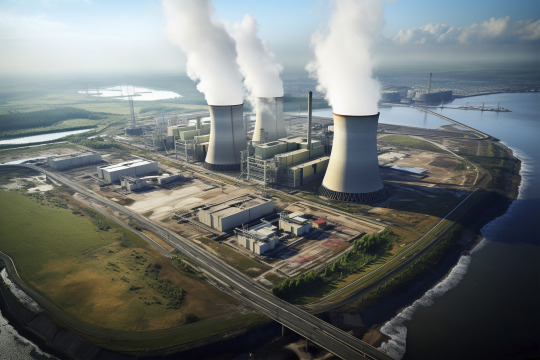
Innovating the Thermal Management System Market
Dive into our comprehensive thermal management system market offerings, meticulously designed to optimize performance across diverse applications. Explore our range of cutting-edge cold plate technology, crafted with precision engineering to deliver unparalleled efficiency in dissipating heat. From electronics to automotive, our solutions are tailored to meet the exacting demands of modern industries. Stay ahead with our innovative thermal management solutions, ensuring your systems operate at peak performance levels, regardless of the operating environment. Trust us to elevate your thermal management strategy to new heights.
#thermal management system market#cold plate technology#Medical#health#Automotive#cooling aerospace#aerospace#military aviation#aircraft#industrial equipment#renewable energy#green energy#heavy equipment#power generation#electronics#photonics#transportation#thermal imaging camera
0 notes
Text
1: dc brushless speed turnstiles barriers
servo motor speed turnstiles barriers is a typical door type, which primarily consists of door frames, door leaves, door deals with and locks. Door frames are generally made of steel plates or wooden boards, and door leaves are made from cardboard, plastic plates or glass plates. The door deal with is a device that pulls or pushes the door leaf open, and the lock is a device that prevents the door leaf from falling out of the door frame. There are normally 2 methods to open a door, one is to pull the door and the other is to press the door. The sliding door is opened by the door deal with pulling the door leaf away from the door frame, while the sliding door is opened by the door handle pressing the door leaf far from the door frame.
2: servo motor wing barrier doors
dc brushless wing barrier gate and servo motor speedgate turnstiles barrier In comparison, train flap barrier gate is created to obstruct water circulation through its horizontal position. On the other hand, dc brushless swing turnstiles gates merely manages the flow of water by altering the vertical position of eviction. city flap turnstile The gate of doors is composed of two gates that can be moved horizontally to control the flow of water. servo motor wing turnstiles Eviction of doors is made up of a gate that can manage the circulation of water by moving vertically.
3: train flap turnstile door
subway flap turnstiles gates, also referred to as movable gate, is a flood discharge facility that prevents the water level from being expensive or too low. When the water level rises to the set worth, metro flap barriers gate will automatically open. When the water level drops to the set worth, subway flap barriers gate The door will close instantly. train flap barrier doors utilizes a water level sensor to monitor water level modifications and controls the opening or closing of eviction to achieve the purpose of immediately controlling the water level.
4: What's the distinction?
dc motor wing barrier doors normally refers to closing the gate, while dc brushless fastlane turntsile barriers refers to opening the gate. city flap turnstile gates and dc brushless wing barrier doors is different from servo motor speed turnstiles barrier. It is a gate installed on the water. And dc motor swing gates door and servo motor speedgate turntsile barrier are gates mounted on the wall.
#swing turnstile door#speed turnstile#Thermal Camera#Face Recognition Infrared Camera#Automated Parking System And Car Barrier#Tripod Turnstile#Remote Parking Lock#Parking Stopper
0 notes
Text
25 Years of Exploring the Universe with NASA's Chandra Xray Observatory

Illustration of the Chandra telescope in orbit around Earth. Credit: NASA/CXC & J. Vaughan
On July 23, 1999, the space shuttle Columbia launched into orbit carrying NASA’s Chandra X-ray Observatory. August 26 marked 25 years since Chandra released its first images.
These were the first of more than 25,000 observations Chandra has taken. This year, as NASA celebrates the 25th anniversary of this telescope and the incredible data it has provided, we’re taking a peek at some of its most memorable moments.
About the Spacecraft
The Chandra telescope system uses four specialized mirrors to observe X-ray emissions across the universe. X-rays that strike a “regular” mirror head on will be absorbed, so Chandra’s mirrors are shaped like barrels and precisely constructed. The rest of the spacecraft system provides the support structure and environment necessary for the telescope and the science instruments to work as an observatory. To provide motion to the observatory, Chandra has two different sets of thrusters. To control the temperatures of critical components, Chandra's thermal control system consists of a cooling radiator, insulators, heaters, and thermostats. Chandra's electrical power comes from its solar arrays.
Learn more about the spacecraft's components that were developed and tested at NASA’s Marshall Space Flight Center in Huntsville, Alabama. Fun fact: If the state of Colorado were as smooth as the surface of the Chandra X-ray Observatory mirrors, Pike's Peak would be less than an inch tall.
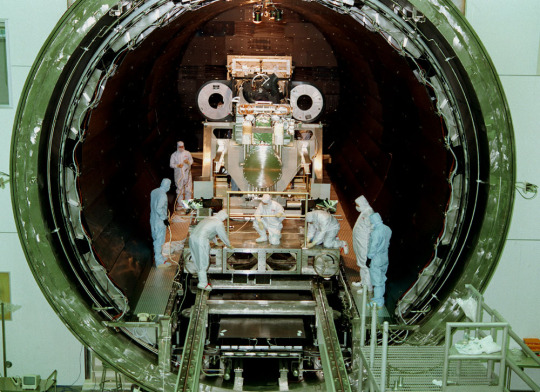
Engineers in the X-ray Calibration Facility at NASA’s Marshall Space Flight Center in Huntsville, Alabama, integrating the Chandra X-ray Observatory’s High-Resolution Camera with the mirror assembly, in this photo taken March 16, 1997. Credit: NASA
Launch
When space shuttle Columbia launched on July 23, 1999, Chandra was the heaviest and largest payload ever launched by the shuttle. Under the command of Col. Eileen Collins, Columbia lifted off the launch pad at NASA’s Kennedy Space Center in Florida. Chandra was deployed on the mission’s first day.

Reflected in the waters, space shuttle Columbia rockets into the night sky from Launch Pad 39-B on mission STS-93 from Kennedy Space Center. Credit: NASA
First Light Images
Just 34 days after launch, extraordinary first images from our Chandra X-ray Observatory were released. The image of supernova remnant Cassiopeia A traces the aftermath of a gigantic stellar explosion in such captivating detail that scientists can see evidence of what is likely the neutron star.
“We see the collision of the debris from the exploded star with the matter around it, we see shock waves rushing into interstellar space at millions of miles per hour,” said Harvey Tananbaum, founding Director of the Chandra X-ray Center at the Smithsonian Astrophysical Observatory.

Cassiopeia A is the remnant of a star that exploded about 300 years ago. The X-ray image shows an expanding shell of hot gas produced by the explosion colored in bright orange and yellows. Credit: NASA/CXC/SAO
A New Look at the Universe
NASA released 25 never-before-seen views to celebrate the telescopes 25th anniversary. This collection contains different types of objects in space and includes a new look at Cassiopeia A. Here the supernova remnant is seen with a quarter-century worth of Chandra observations (blue) plus recent views from NASA’s James Webb Space Telescope (grey and gold).

This image features deep data of the Cassiopeia A supernova, an expanding ball of matter and energy ejected from an exploding star in blues, greys and golds. The Cassiopeia A supernova remnant has been observed for over 2 million seconds since the start of Chandra’s mission in 1999 and has also recently been viewed by the James Webb Space Telescope. Credit: NASA/CXC/SAO
Can You Hear Me Now?
In 2020, experts at the Chandra X-ray Center/Smithsonian Astrophysical Observatory (SAO) and SYSTEM Sounds began the first ongoing, sustained effort at NASA to “sonify” (turn into sound) astronomical data. Data from NASA observatories such as Chandra, the Hubble Space Telescope, and the James Webb Space Telescope, has been translated into frequencies that can be heard by the human ear.
SAO Research shows that sonifications help many types of learners – especially those who are low-vision or blind -- engage with and enjoy astronomical data more.
Click to watch the “Listen to the Universe” documentary on NASA+ that explores our sonification work: Listen to the Universe | NASA+

An image of the striking croissant-shaped planetary nebula called the Cat’s Eye, with data from the Chandra X-ray Observatory and Hubble Space Telescope. NASA’s Data sonification from Chandra, Hubble and/or Webb telecopes allows us to hear data of cosmic objects. Credit: NASA/CXO/SAO
Celebrate With Us!
Dedicated teams of engineers, designers, test technicians, and analysts at Marshall Space Flight Center in Huntsville, Alabama, are celebrating with partners at the Chandra X-ray Center and elsewhere outside and across the agency for the 25th anniversary of the Chandra X-ray Observatory. Their hard work keeps the spacecraft flying, enabling Chandra’s ongoing studies of black holes, supernovae, dark matter, and more.
Chandra will continue its mission to deepen our understanding of the origin and evolution of the cosmos, helping all of us explore the Universe.
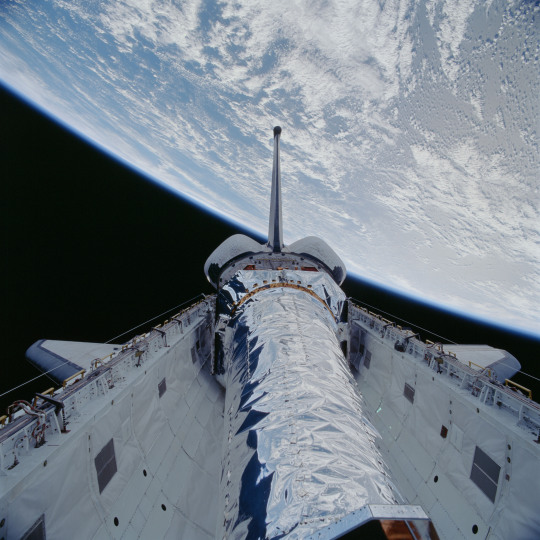
The Chandra Xray Observatory, the longest cargo ever carried to space aboard the space shuttle, is shown in Columbia’s payload bay. This photo of the payload bay with its doors open was taken just before Chandra was tilted upward for release and deployed on July 23, 1999. Credit: NASA
Make sure to follow us on Tumblr for your regular dose of space: http://nasa.tumblr.com
2K notes
·
View notes
Text
Relentless direct action has secured another victory in the fight against Israel’s arms trade, as Elbit Systems are forced to sell their ‘Elite KL’ factory in Tamworth.
The company had previously manufactured cooling and power management systems for military vehicles, but was sold on after stating that it faced falling profits and increased security costs resulting from Palestine Action’s efforts.
After the sale was completed last month, Elite KL’s new owners, listed as Griffin Newco Ltd, confirmed in an email to Palestine Action that they will have nothing to do with the previous owners, Elbit, and have discontinued any arms manufacturing:
“Following the recent acquisition of Elite KL Limited by a UK investment syndicate, the newly appointed board has unanimously agreed to withdraw from all future defence contracts and terminate its association with its former parent company”.
This victory is a direct result of sustained direct action which has sought, throughout Palestine Action’s existence, to make it impossible for Elbit to afford to operate in Britain. Before they sold the enterprise to a private equity syndicate, Elbit had reported that Elite KL operating profits had been slashed by over three-quarters, with Palestine Action responsible: Elbit directly cited the increased expenditure on security they’d been forced to make, and higher supply chain costs they faced.
And these actions did, indeed, cost them. The first action at the site, in November 2020, saw Elite KL’s premises smashed into, the building covered in blood-red paint. Between March and July 2021, the site was put out of action three times by roof-top occupations – drenched red in March 2021, with the factory’s camera systems dismantled, before again being occupied in in May. Another roof-top occupation in July, despite increased security, saw the site forced closed – once again painted blood-red, and with its windows and fixings smashed through.
In February 2022, activists decommissioned the site for weeks – closed off after an occupation that saw over £250,000 of damages caused, the roof tiles removed one-by-one. After this, Elbit erected a security perimeter around the site – but to no avail. One month later, six were arrested after Palestine Action returned to Tamworth – again taking the roof and smashing through, preventing the production of parts for Israel’s military machine.
Elite KL is a ‘specialist thermal management business’. Since the sale, the company focuses on cooling systems for buses and trains, but it had, under Elbit, manufactured these systems for military vehicles. Until December of last year, Elite KL’s website was advertising its military and defence products, and it was known to provide parts for Israel’s deadly Merkava tanks, with export license records demonstrating its provision of ‘ML6a’ components for military ground vehicles to Israel. The company was also known to manufacture crew cooling systems, for the military vests of tank operators.
Elbit Systems itself provides 85% of the drones and land-based military equipment for the Israeli military, along with a wide range of the munitions and armaments currently being used against Gaza’s beseiged population. Its CEO, Bazhalel Machlis, has claimed that the Israeli military has offered the company its thanks for their “crucial” services during the ongoing genocide in Gaza
A Palestine Action spokesperson has stated:
“Each activist who occupied and dismantled Tamworth’s Israeli weapons factory did so in order to bring an end to Israel’s weapons trade, and to end the profiteering from Palestinian repression. Every defeat Elbit faces is a victory for the Palestinian people.
Kicking Elbit out of Tamworth shows once again that direct action is a necessary tactic. It is one which must be utilised and amplified in the face of the Gaza genocide.”
3K notes
·
View notes
Text
Fill the void
Pairing : Caleb x non MC reader Content :rough sex , aphrodisiac sex , oral sex (fem receiving) , slight bondage, inappropriate use of evol , slight exhibitionism, unprotected sex, MC's cameo , reader evol is mentioned, porn with plot , creampie (use protection guys ) Wk: 6.9 k (MF *side eye* ) Synopsis : when you fled on that island to save your comrade you didn't expect it to turn into forced vacation with the very reason of your jealousy. Part 2 to Heartless A/N: this part 2 wasnt planned but Caleb got me feeling some type of way . I need this man to rail me on top of a desk with his uniform still on and Call out my name playing in repeat in the BG. (Zayne be filling papers divorce after he heard say that) Now playing: Fill the void by The weeknd and Lily Rose Depp.

Fill the void.
Maybe that’s what you were desperately trying to do with Caleb’s presence in your life. Fill the enormous void in your heart and soul.
You didn’t know who avoided who at this point. Was it you or him? Who cared, anyway? He had his pipsqueak back. You just minded your own life and business now.
“It seems there isn’t anything wrong with that area,” you heard Commander Ash’s voice crackle through your headset.
“They must be hiding. Keep looking,” you replied, voice cool and controlled as your eyes scanned the real-time images from his UAV camera feed.
Usually, missions involving Protocurve anomalies fell under the Hunter Association’s jurisdiction, but the unusual readings near the Farspace Fleet-controlled zone warranted your team’s intervention. The fluctuations were too erratic, too dangerous to ignore.
A sudden crash broke through the static, followed by a sharp burst of white noise. Then, silence.
“Commander Ash! Can you hear me?” Your voice pitched higher as your fingers scrambled over the console. “Ash, respond!”
No answer.
Shit.
Ripping the headset off, you spun out of the command room, ignoring the shouts of other soldiers as they tried to stop you.
“Lieutenant General! Protocol requires—”
“I need Hershley 4543 prepped and ready for immediate departure!” you barked, cutting them off as you stormed into the hangar.
“Ma’am, that’s against—” the mechanic stammered, stepping forward.
“No buts! One of our own is out there, and I am not leaving him behind,” you snapped, your voice razor-sharp, thought your hands were trembling betraying the panic bubbling just beneath your façade.
The mechanic hesitated for a moment, then nodded, shrinking under your unwavering gaze. “Understood. We’ll have it ready in five.”
“Make it two.”
…*...*...*...*...*...*...
You climbed into the cockpit of the Hershley 4543 -a sleek reconnaissance aircraft equipped with stealth capabilities and advanced tracking systems. The roar of the engines was deafening, but it grounded you. You went through the pre-flight checks with practiced efficiency, hands flying over the controls as the team cleared you for takeoff.
Rushing into danger like this was beyond reckless. You knew that. But Commander Ash was an ally -a friend even, though you’d never admit it aloud.
“Flight control to LTG,” a voice crackled in your ear. “Tracking a spike in Protocurve readings at your target location. You sure about this?”
You flicked the comm switch. “I’ll handle it. Just keep the airspace clear.”
…*...*...*...*...*...
The flight to the designated zone was uneventful—eerily so. The clouds parted to reveal an expanse of barren terrain. From the air, everything seemed peaceful. Too peaceful.
You adjusted the thermal imaging on your monitor, scanning for any sign of Ash or the Wanderer he’d been tracking. The anomaly readings were spiking, but there was no visual confirmation.
“Come on, Ash. Where are you?” you muttered under your breath, gripping the controls tighter.
A loud thud made your ears perk up , your senses in high alert as you heard a faint curse.
What the actual fuck ? you quickly took off your headset ,shifting the commands on automatic pilot mode before standing up to explore what on earth was happening in the back of your plane.
Your steps were as silent as the plane 2 minutes ago and you were starting to think the curse you heard earlier was just a trick of your imagination .As you approached the source of the noise , your right hand reached for your sidearm.
You opened the curtain separating the rest of the plane from the cockpit ,gun raised and ready only for your eyes to fall on that hunter girl
What was Caleb's pipsqueak doing aboard an Airforce plane ?
“What the fuck are you doing here?” You heard your voice said , your eyebrows furrowing in a confused frown that had the girl in front of you gasping.
You didn't lower your gun even as she scrambled onto her feet, her hands raised in surrender.
“Don't shoot , I am not an enemy” her voice was a pitched squeal that had your irritated nerves fraying further.
“This is an Air Force operation , why are you here?” You asked, finally lowering your gun , the sigh of relief that left her lips didn't escape you.
“I heard there is a wanderer involved and I happen to be a hunter so I thought I could help”
You scoffed at her words before placing your gun back in the holster.
“And you think boarding without permission on an airplane in mission is helping” you hummed sarcastically as you made your way back to the cockpit
her hands curled into fists at your blatant dismissal , a small frown etched on her features as she followed closely behind you .
“I am here to help” she repeated, her voice edged with an hint of frustration “not to be a burden”
“Just you standing there and breathing is already a burden for me” you bit back before placing your headset back on, though your tone was cool and controlled the venom dripping from your words stung harder than she cared to admit
Just her existence was already a burden you thought, eyes fleeting back to the faint signal that appeared on your screen.
If she was the least offended by your words, she didn't show it . After all, you were known among the Farspace fleet for your temper and sharp tongue. And despite being there only for a short amount of time , she seemed to have already picked up that information.
She leaned against your seat to peer up over your shoulder at the monitoring screen where you could see the faint signal of Ash's locator
What does she think she's doing ? The poisonous look you gave her would have probably sent her 6ft deep underground if only looks could kill but it didn't even make her flinch.
“If you're planning to tag along stay out of my sight unless you want to find out what happens when you jump off a plane without parachute” your icy tone and the not so subtle menace in your words made her gulp audibly but she didn't leave as you hoped, instead to your growing irritation she plopped herself in the co-pilot seat beside you , her eyes scanning over the command board like a curious child
Just what the heck is wrong with her ?
Whatever you shook your head before focusing back on the beeping signal of Ash's locator on your screen
As long as she kept her mouth shut , Everything would be fine . You'd just have to pretend she wasn't there.
But of course she wouldn't keep her mouth shut .
“I can sense something” she whispered mostly to herself as she stared at the beeping hunter watch on her wrist but it didn't escape your ears
Your eyes flickered towards her for a fraction of second before refocusing back on the monitoring screen where you could see how much closer you were getting to Ash's location
“Hold tight, hunter. We are about to land” you warned her before preparing for the descent.
She scrambled onto her seat, her hands gripping the armrest for dear life . The sight almost pulled a small smirk from you but you quickly schooled your features back in their usual stoic mask .
…*...*...*...*...*...
Even as you landed on the small island where Ash’s coordinates led you , everything was still peaceful, way too peaceful. Though that hunter girl insisted on the fact she could sense something, your surroundings were nothing short but the picture perfect of a small tropical paradise.
“It must be here” you heard her whisper to herself, her feet pacing back and forth on the shimmering white colored sand as she stared at that damn watch.
“Stop pacing around like that , it's making me dizzy” you finally snapped, making her freeze in her tracks to look at you .
“The signal said that Ash is there” you pointed at the dense forest at the edge of the beach
“But the fluctuations are coming from this wa-”
“We don't give a fuck about the fluctuations” you cut her off ,your voice icy cold as you stepped closer to her “we are here to save my friend and not to play hunter x hunter so either you stay here and get killed by whatever is lurking on this island or you come with me”
She contemplated your words for a moment, her teeth nibbling at the plush of her bottom lip for a moment before she finally spoke
“Go , I'll manage alone” not the answer you expected but if she seemed determined to find this wanderer
“Very well” you let out a faint chuckle before turning on your heels to head towards the forest where you'll probably find Ash without sparing her a second glance
What ? She thought you'd bring her by a leash after you . She's a grown ass woman and can perfectly manage herself. Well you hope
If anything happens to her , Caleb will be devastated though. That torturing voice muttered in your ear .
Fuck no .
You weren't her damn babysitter and you didn't give a fuck about what Caleb thought or how would he feel if something happened to her . Hell you didn't even give a damn about Caleb anymore.
But even as you told yourself that , your legs were already jogging back to where you left her
“Damn hunter” you muttered as your searched frantically on the beach but she was nowhere to be found , only the clear blue seawater and dusty sand was looking back at you
Sorry Ash but hunter first then I'll save your ass.
…*...*...*...*...*...
You didn't know for how long you've been roaming endlessly on that island , searching for Ash and that damn hunter. You could easily leave her to perish there . After all it would quite the sweet revenge and finally satisfy your petty jealousy but you weren't letting anyone die on your watch not today
You can always look away that same persistent voice whispered but you quickly shook it off.
The dead branches creaked beneath your feet as you walked further into the forest , the eerily silence almost suffocating. It was too quiet to be normal. Not even a bird chirping sound ,That was beyond odd.
A faint rustling made your ears perk up , your hand already pointing the gun in whatever direction it came from but to your surprise and relief you found the hunter girl and Ash attached and suspended like sausages by the vines
No they weren't vines
“Lieutenant don't get any closer” Ash shouted, his voice laced with concern while the hunter was trying hard kick off those viscous tentacles around her legs
You raised your gun to shoot but she interrupted you .
“This doesn't work on them, see” she gestured to her gun laying on the grassy ground “wasted my whole magazine while trying to hit it” she sighed , her hands hanging loosely beside her head.
You cursed lowly under your breath before grabbing the blade hidden in your boot to attempt to cut off those damn tentacles like vines or whatever they were
“Why are you here , Lieutenant?” Ash asked, earning a dirty glare from you
“Saving your ass, of course” you let through gritted teeth before slashing through the vines to free him.
He fell on the ground with a loud thud , his gloved hand reaching out to massage his head that got hit at the fall.
You stepped over his body to cut off the restraints still curled around the hunter girl. She fell flat on her ass with a small gasp before sitting up.
“Let's not hang around for too long” you suggested already helping Ash standing to his feet
But you knew by the way she was observing the weird vines like tentacles you would definitely hang around for a while.
“I've never seen a wanderer like that” she whispered fascinately , her hands already reaching out to touch it but you stopped her halfway
“So what?” You scowled, grabbing her wrist to stop her from touching the weird object “new kind of wanderers appears everyday it's not the moment to play mad scientist, hunter” you tugged her along wanting to get out of this island as soon as possible
“But shouldn't we kill it?” She asked while you dragged her the further away possible from this wanderer .
“That wasn't our mission, Commander Ash was sent in reconnaissance and I went out of my way to save him” you explained not sparing her a glance while you navigated through the dense foliage with Ash trailing behind you.
She seemed to understand your point thought the unimpressed look she gave you made you want to abandon her in this wanderers infested island
Yeah maybe you should do that .
But as you were concocting a plan to secretly ditch her and fly away with Ash in your head , A shrieking sound made you grab your gun quickly, eyes roaming around the tall trees as you and Ash almost sandwiched the hunter girl between your bodies , senses in high alert
“Stay right behind me and don't move” you warned her , your voice low and controlled as your eyes scanned the surroundings area searching for any signs danger
And then it came , from above a dragon-like wanderer surged from nowhere, his clawed limbs aiming straight toward the hunter girl behind you.
You quickly spun her around to fire at the beast but it dodged your attack with maddening ease
Fuck.
“Another one!?” you heard her whisper in a ragged voice
“An enormous one apparently” you spat before recharging your gun.
The dragon wanderer roared again before surging forward, his attack still aimed at the hunter girl
Just what the fuck did it wanted from her ?
You and Ash continued to shoot at it but it seemed useless , the bullet ricocheted against his scales covered skin with ease
Shit ,at this rate you'd have to use your evol.
You pulled on the trigger only to realize you no longer had bullets.
Crap
“Commander” you looked over Ash who was hiding behind a tree.
He shook his head , his own magazine empty.
Fuck what do we do ? You looked down at the grass covered ground your mind racing a mile per minutes
“Maybe I can try to resonate with it” the hunter girl suggested making your gaze snap back at her
“You have the resonance evol” you and Ash exclaimed at the same time making her look at you with a puzzled gaze
“Yeah” she murmured, her head tilting slightly to the side in confusion
You exchanged a knowing look with Ash , your mind conveying the same thoughts
You'll have to use your evol . Unlike you two Ash wasnt an evolver and your evol , well you hated it or to be more franc you hated to use it because things always ended up spiralling out of control when you did.
But this time you didn't have any other choice and even if you absolutely despised this hunter you couldn't let her die .
Don't get you wrong , if she die it might look bad for your career.
“I am not going to ask you to trust me because I know you don’t and to be honest I do not either so are you ready to risk your life to get out of here Miss hunter?” You asked with an outstretched hand
An invitation, a deal for the survival of you 3.
She looked longly at your hand before grasping it.
“well ,it's not like I have another choice” she breathed out before squeezing your hand.
You let an half hearted achuckle before yanking her to her feet to step out from behind the tree you were hiding behind .
You heard the shrieking sound again before catching a glimpse of the dragon surging towards where you were standing .
You can do this. Don't think about the experiment , the thunder , the electroshocks.
Your eyes closed as you felt the burst of energy ran through your body , images of a young girl that wasn't yours flashing through your eyes .
Caleb ? Why was he in those memories that weren't yours?
You heard the clap of thunder before the shrieking sound grew louder . Another clap , louder than the previous one . The shrieking sound turned into a faint howl.
You heard a distant call of your name but you couldn't respond, the image in front of you making your gut twist .
Caleb was gently cradling her cheeks as he wiped her tears . So this was what love felt like ?
You could feel everything: how his warm hands glided over her face , the faint words of reassurances he whispered to her , the light kisses he left against her temple . You could feel it all and it hurts, it hurts so bad it had you sinking on your knees
So this is what it feels like to be loved ?
The sting of a slap wrenched you out of this loop of torture. The heart wrenching images of Caleb consoling his pipsqueak shattering in your mind .
You blinked your vision back only to see the hunter and Ash's concerned faces looking down at you .
“What happened?” You heard yourself ask, your voice sounded hoarse as your eyes roamed around to take on your surroundings . What was once a lush land of tree and foliage was now burned down to ashes
“Where's the wanderer?” You questioned them
“Dead,” the hunter girl replied in a small and distant voice ,her eyes looking down in a way you didn't like at all .
“2 thunderclap was all it took” Ash added while avoiding your gaze
Why were they acting so strangely?
You hummed in response before standing up . Half of the forest was burned down leaving the giant wanderer laying on the center of it.
You approached it slowly , your steps deliberate as Ash and the hunter observed you from behind , their mind still struggling to comprehend what just happened.
When you were at the dead wanderer's level you crouched down to observe it more closely. A disgusting smell of burnt flesh was coming out of it , the nauseating scent so strong it had you pinching your nose
But as you observed it ,a glowing light caught your attention making You lean in to take a closer look.
Only when you reached to touch it ,it exploded in a cloud of pink smoke that surrounded you.
You coughed out as you waved it off with your hands but only one whiff made your head spiral uncontrollably. It smelled so addictively good , the piney scent reminding you of Caleb ?
Huh? you quickly shook off your head ,hoping the smell would disappear but it persisted making your mind grow hazier by the seconds.
“Lieutenant” you heard Ash shout making your eyes snap back to his form who was already jogging towards where you were standing
“We need to leave” he breathed out making you nod in agreement
“You are right let's go”
“Are you alright?” He asked , eyes squinting to observe you more closely, taking in the unusual flush of your cheeks.
“Why wouldn't I be?” You retorted ,voice tenser than you intended. You internally winced at how his face fell at your harsh tone, his eyes darting away awkwardly.
“Let's just get the hell out of this island ” you added with a last glance at the wanderer’s corpse before starting walking ahead .
Ash followed closely behind you , often shooting concerned glances as you made your way back to the airplane.
Once inside your case worsened further . You felt your body growing more heated by the seconds, your tie feeling too tight around your neck.
You loosened it before running an hand through your hair . Miss hunter (that was the new nickname you gave her) keep shooting you curious glances along with Ash , finding your fidgeting unusual even for the short amount of time she has spent with you
“Are we arriving soon?” You asked for the nth time, heavy pants leaving your parted lips as you leaned against your seat
Why did it feel so hot in here?
“We'll be landing in approximately 32 minutes” Ash responded to your question
32 minutes . that was far too long
You needed to breathe, to drink water , to see Caleb
Caleb ? no , not Caleb
“Fuck” you breathed out before taking off your jacket . The heat too unbearable
“Are you sure you're alright?” You heard the hunter ask ,a hint of concern lacing her tone as she watched you struggle with unbuttoning the top 2 buttons of your shirt.
“I am fine” you replied but the way your head was spinning uncontrollably was clearly proving you wrong.
You brushed it off as a side effect of whatever that pink smoke was but when you landed it only worsened to the point you were stumbling toward your office room, leaving the debriefing to Commander Ash .
You closed the door shut before walking over your chair to plop yourself on it.
You still felt like you were burning up , every fiber of your being screaming for a man who didn't even want you -need you the way you did.
“What have you done to me Caleb?” You sighed as you leaned your head against your chair , your eyes looking up at the white ceiling as if it had the answers of your questions but it didn't. No one did .
You let out another heavy sigh before discarding your tie on your desk to see if you'd finally breathe properly .
Just as you thought you might be getting some rest from this unbearable heat that have been creeping up on your body your door fled open revealing an angry Caleb
The sight of him , especially mad made your whole body throb with an intensity that should be concerning but your mind was way too clouded to care.
He stepped closer to your desk , the clicking sounds of his boots along with your thumping heartbeat the only sounds registering in your mind.
“What makes you think taking her on such a dangerous mission was a good idea ?” You heard him say , his voice barely able to contain his anger.
His words cut sharply through your daze , your eyes blinking back to focus on anything but the way his face looked so distractingly attractive
“I didn't take her anywhere” you said, your voice sounding way too calm and steady for someone who was literally burning in the inside “your pipsqueak boarded on that plane without permission like a grown up” you added earning a scoff from him
“You expect me to believe she managed to pass all those security guards to board on a plane with you out of all people” he leaned in to rest his hands on your desk , his eyes shining with a possessive gleam that wasnt directed at you but got your heart rate spiking nonetheless
“What ?” You tilted your head mockingly at him before raising from your seat to lean closer towards him “you expected me to put a gun on her temple to force her fly away with me on an wanderer infested island only to come back unscathed” you added in a heated whisper against his ear that had his jaw clenching
“Think wisely Caleb” You scoffed before stepping away from him , attempting to put some distance between you , to quell down the hunger that stocked further inside you the more you inhaled the addictive scent of his cologne
But Caleb wouldn't let you off the hook this easily . As you walked beside him to head to your office door , he pulled you towards him by wrapping his hand around your wrist.
An embarrassing squeal left your parted lips as you felt your back hit the wooden material of your desk .
“Have I ever told you that jealousy looks awful on you , Lieutenant?” You felt the ghost of his lips against your heated skin as he whispered the words against your neck
“T-this has nothing to do with jealousy” you heaved out , already panting while he hasn't even touched you yet .
“It doesn't hm?” He purred against the soft flesh of your neck before biting on it hard enough to have you clawing at the edge of the desk “then why have you been avoiding me?”
The question made your eyes widen the suddenness of it too abrupt for your scrambled mind to process .
“Tell me , lieutenant” he pressed, his lips leaving a gentle kiss on the bruised skin he bit earlier .
“You have your pipsqueak back our deal is supposed to be over” you managed to get out between feverish pants.
The flash of disappointment you saw through his eyes had your resolve faltering but the fragment of memories you saw when you resonated with the hunter earlier strengthened it further .
Don't get caught up in illusions. This man wasn't yours.
The realization made a burst of anger spread throughout you , one that had you yanking his hair harshly until your lips crashed against his, all teeth and tongue , drinking him in like a thirsty man in desert that finally found water. Because he was your water , your light , a light that was bound to leave you .
Caleb kissed you back with the same fervor, his gloved hand wrapping lightly around your throat as his mouth devoured yours with a feral intensity. It was messy ,depraved and desperate.
A small hushed plea left your mouth as he parted his lips from yours to trail kisses down on your neck. His hands were everywhere , caressing any inch of smooth skin he could reach
Your own hands reached out to unbuckle his belt but he stopped you halfway , his hand moving swiftly to bound your wrists with your own discarded tie.
“No touching this time Lieutenant” he taunted, cupping your chin to make you look up at him , the feral gleam in his purple eyes making your cunt throb harder.
“Today you're all mine” he whispered before capturing your mouth in another heated kiss.
How you wished you could be his but this would never happen. You were just a sinner and he was your worst sin. The one who will drag you through the pits of hell.
The small kiss he left on your nose was the last thing you felt before he slid down to his knees in front of you , his large hands spreading your legs apart as you tried to steady yourself on top of the desk despite your bound wrists.
His fingers unzipped your pants before sliding them off you , leaving your legs bare for him to admire
How he has missed this view .
“Still as beautiful as ever , Lieutenant” you heard him whisper in awe, the compliment making you feel even dizzier while your cunt fluttered uncontrollably at his praises
“Look at her” he looked up at you as he ran a gloved thumb along your covered slit “so wet for me already”
You could feel his infuriating smirk against your plush fold through the flimsy material of your panties . He was so close but so far away at the same time, it drove you wild.
“Caleb” you whimpered out , your pleading eyes looking down at him in an half hearted glare that made his cock twitch
“What?” He smirked before peeking the drenched material of your panties in a way that had you throwing your head back
“What do you need , darling?” The sound of him calling you darling made your hips buck against his face , the sinful moan escaping your lips sounding like music to his ear.
“I need you” the words felt more like a confession than anything and if it wasn't for that weird wanderer based substance in your system you'd probably felt pathetic for baring your soul to him like this but right now as his face was resting between your legs seconds away from feasting ,you didn't give a damn.
The regrets and sermons would come later when you were no longer aching and panting from him .
The heat of Caleb's mouth pulled you out of your musings, the overwhelming sensation making you cry out loud . He hasn't even bothered to take off your ruined panties , his mouth latching onto the flimsy material like he was starving.
He was merciless, the relentless pace making you squeal.
“Oh fuck just like that” you moaned, not even ashamed of the sounds you were making. His tongue rolled over your swollen bud over and over until you were practically in tears .
When you felt like you'd finally reach heaven ,a knock to your door made him stop, his eyes looking up to take in your form.
And shit. The sight of you spread out on your desk with your shirt half buttoned, your skin flushed with heat , panting with tears clinging to your waterline almost had him cumming in his pants
Such a sight to behold and all for him to see.
Another knock on the door made him let out a small growl against you , clearly not pleased by being interrupted .
“Lieutenant” you heard a worried voice said from the other side “can I come in?”
Commander Ash? Your ears perked up .
Shit shit shit why is here ?
You looked down at Caleb who was already back to work , his fingers pulling your ruined panties to the side to suck , lick and nip at your sensitive flesh while you tried your best to stay quiet and gather your thoughts
“Lieutenant” Ash knocked once again “are you alright in there?” his voice was growing somewhat more restless.
“Respond darling” you felt Caleb's nip gently at your clit before looking up at you from where he was kneeling “it's so rude to leave someone hanging hm?” He spat right on your entrance before slurping down the mess.
“ngh_” the sight of him looking so devilishly at you nearly had you cumming right there on his face but he purposely slowed down his pace to maddening kitten licks so you would focus on responding Ash.
But that only made you more restless and frustrated .
“I am fine” you snapped , voice laced with frustration while the man below faintly chuckled before rewarding you with a flick of his tongue that made you groan .
You fought against your restraints so at least you would cover your mouth to muffle your sounds but no matter how hard you tried the knot wouldn't loosen .
Handsome bastard.
“Are you sure?” you heard Ash said , the confusion note in his tone not escaping Caleb's ears.
“You don't really sound well” the sound of the creaking handle made your heart rate pick up . your stomach curled into knots with a mixture of fear and arousal that has fresh waves of your beading juices gushing around Caleb's tongue
You didn't lock the door and he could barge in at any moment
“Dirty girl” he muttered faintly against your plush folds , sticking strands connecting his lips to your pussy .
You bit down on your lips to not let out a loud moan , the squelching sounds of your cunt along with your barely concealed moans leaving no doubt of what was happening inside there . Thought one thing was clear , Ash was clearly wrestling with the handle that wouldn't budge Thanks to Caleb's evol.
“I am fine truly” you attempted to spoke again but the way Caleb was making out with your lips below while his gloved hand rubbed tight circle around your clit made your words came out like breathy whimpers. “Just a bit busy”
You really hoped Ash would get the memo and get the fuck out here before you combusted .
“Ok then” he said, his tone sounding a tad disappointed “I'll see around then Lieutenant”
Yeah you'll see her around now go .
You felt a wave of relief wash over you as the sound of Ash's eloigning footsteps finally disappeared leaving only you and the smirking man still buried nose deep between your thighs.
“You're such a dirty little thing , Lieutenant” he rasped out , flicking your clit one last time before raising to his full height .
“And you're such a tease” you scowled before feeling him unbound your wrists.
As soon as they were free you tugged him by his tie to capture his lips in a messy kiss , your mouth sucking lewdly on his tongue , tasting yourself on him
“We both know you love that tease, darling” he mumbled out between kisses
If only he knew how right he was
“No I hate you” you denied ,your grip tightening hard enough on his tie to make him lightheaded and the fucked whimper that left his mouth as you did so made your cunt howl his name in morse code.
“Biggest lies I've heard in a while Lieutenant” he panted out with a smirk, his hands gripping your hips so hard they'd probably leave marks.
“guess we are both liars then, Colonel” you tugged at his tie again earning a breathy “fuck” from his slick glossed lips .
Lying was all you ever did your whole life . You lied about your feelings, your past , you even lied to yourself. You were a liar , a sinner and he was your biggest sin.
The distant look that passed through his lust filled eyes didn't escape your attentive gaze and it made you thought for a moment :
Was he thinking about her ? Did he has the same regrets you had? Did he feel the same burning hunger you felt ? The one that threatened to consume you.
Alas you would never get the answer of those questions because next thing you knew is that he was kissing so hard you would have fell on the ground if it wasn't for his hands looped around your waist.
You could feel every hard planes of his body against yours ,even through the material of your half off uniform shirt , the intoxicating scent of his cologne making your head spin.
Your reached for his belt once again and this time he let you had your way, too busy eating out your face to stop your wandering hands.
Just this once . You heard this voice whisper again .
Caleb's head fell against your shoulder when he felt your soft hand wrap around his shaft to pump it slowly.
It was hot and heavy in your hand, the leaking precum coating your palm in a sticky mess.
He bit down on the plush skin on your shoulder to muffle his sounds , his hips thrusting in time with your movements.
Wanting to get your revenge on the stunt he pulled on you earlier , you slowed down your pace until you could hear his muffled whimpers against your shoulder
“What's wrong?” You cooed , leaning your head back to stare at him , his cheeks were flushed the prettiest shade of pink , his hair tousled from your ministrations , his kiss bitten lips parted open to let out the hottest sounds you’ve ever heard .
You must been smiling too widely for his taste because the feral glare he shot you made you anything but scared , it only had you more turned on than ever.
But as always Caleb wouldn't let you savor your victory for too long , using his evol as the awful bastard he was to manipulate your hands until they were bound behind your back once again
“Nothing's wrong Lieutenant” he rasped before pulling your legs to wrap tighter around his waist , his pinkish tip teasing your entrance.
“Just thinking about how hard” he punctuated his words with a rough thrust that had you clawing at his shoulders , the sensation of him stretching your insides too overwhelming. “I am going to take you” he added in a heated whisper before setting a brutal pace that had your desk shaking maddeningly , important papers scattering on the floor in a mess you'd have to worry about later.
Caleb's hips were merciless, fucking up into you like he hated your gut (as if he wasn't deep in them) . You clung to his uniform jacket sleeve for dear life , afraid you might slip but with how sandwiched you were between the wooden desk and his body you shouldn't be worrying about that.
“Oh fuck” you threw your head back when you felt him hit that exact spot that has you seeing stars , body arching into his to bring him closer. Your hand grabbed at his tie to pull him closer to you as his hips kept pistonning into yours .
“Yeah let me hear you, darling” he placed one hand on the desk beside you while the other pulled your leg over his hip to reach even deeper into you.
Every forceful thrust planted on the bulleyes of your G-spot has your grip tightening on his tie hard enough he could now see white spots blurring his vision .
You were gonna be the death of him , (literally) .
The smell of sex and skin slapping sounds filled the room along with your scream of pleasure and his breathy groans as he literally wrecked you , molding your insides to his shaft until all you can think about was him and only him .
“You squeeze me s’tight” he groaned against your neck , his hips not easing his pace for a second , not when your greedy pussy was sucking him back in so perfectly at every thrust .
His hand that was planted beside you , slid up to wrap around your neck , putting enough pressure on your throat to have your eyes roll in the back of your skull.
“Come for me” he whispered before ducking his head down to bite on the plush skin of your collarbone. The action had you screaming loudly, the waves of pleasure crashing you over you like a sea storm. It was violent, leaving you shaking for several seconds as he continued to drive himself deeper into you , not even stopping when he reached his own high . Sensitive shaft twitching uncontrollably as he painted your insides white .
“Take it all , darling” he whimpered in the crook of your neck , puncturing every words by a sharp bite of his canines.
You sobbed in overstimulation. Your head resting against his chest as you murmured soft plead for him to stop.
“Shh” he shushed you with a gentle kissing your tears on your cheek that contrasted his hips below “just take it”
He licked your tears away before kissing you with an unusual tenderness while he continued to fuck you roughly.
You cried out as your second orgasm washed over you ,your whole body convulsing against his as your hand practically tore his uniform jacket with how good it hurts.
Caleb's body jerked against yours, his head dropping in the crook of your neck as he reached his peak for a second time , pace finally slowing down to let you breathe.
You stayed like this for several minutes, wrapped in each other's embrace as you desperately tried to catch your breath.
As the fluffy cloud of pleasure dissipated the ungly truth came back to slap you right back on your face .
You succumbed to the sweet temptation Caleb was once again. Even as you promised yourself you wouldn't get involved with him again , here you were half naked with him still buried deep inside of you.
You attempted to push him off you , the action making him raise his head from the crook of your neck to shoot you a confused look.
The audacity to appear confused. You scoffed internally.
“You should go” you heard yourself say , your voice hoarse from screaming his name too loudly .
His brow knitted together, clearly struggling to understand your point .
“It'll be troublesome if someone find you here” you explained calmly , acting as if he wasnt ramming into you 5 minutes ago.
“I am aware” he replied with that same confused note in his tone, still not making any moves to get the fuck off you.
“Then get off” you glared at him causing him to sigh
“You're trying to run away again” he caressed your legs softly with a pensive look in his eyes
“I am not trying to run away, you dirtied me with your seed and I just want yo go the bathroom so get the fuck off me” you scowled stil trying to push him away
Your words earned a barely muffled laugh from him. His eyes gleaming with barely concealed amusement.
“I am sorry” he left a small kiss on your nose that made your heart melt “I thought you'd enjoy the mess”
“Well I don't, so get off” you let out in a small grumble
“You're always so bossy , Lieutenant” he chided softly before picking you up making you wrap your arm tightly around his neck
“You should ease up a little” he added , carrying you towards your personal bathroom to clean you up.
“And you should know by now that I don't take advices from you” you bit back .
The only thing you should ease is probably a gun down his throat.
“Sure you don't” he said with a small smirk before pushing the bathroom door open with his feet to get you inside.
After cleaning you up in a remotely peaceful silence , Caleb left you alone in your office to muse on your thoughts.
Just when will this madness end?
Just when will you stop being attached to him? The response was clear : never because no matter how much he hurt you? And how hard you tried to stay away from him. You'll always find your way back . Like a drug addict , you were addicted to him. Addicted to his poison . A poison that will probably end up killing you
BAM .
The end (or no)
Taglist : @cheezeandkrackers @dollyvheart @gazelover666 @miyuki-hanna @cordidy @full-sunnies @aise-30 @vvintqz @tavviet @sanghyuksgasolinestationscream
#love and deepspace#love and deepspace x reader#lnds#Caleb#Lads#Lads Caleb#Caleb smut#Caleb x reader#Lnds Caleb#Caleb x you#Love and deepspace#Fic#Smut#Lilieswrite
346 notes
·
View notes
Note
Omg! Panty stealer pt2 is sooooo gooood! Cocky and dom Peter absolutely blew my mind! Your writing is awesome!
Pleeeeease tell me that it will be third part to fulfill the panty trilogy! As humble suggestion maybe reader find out that Pete is SpiderMan and he will finally get head from her while he is in his spidey costume? Or maybe more than just blowjob?Hehehe Am I very bad and naughty that I'm typing this to you? 🥵🤤
Anyways love ya darling! You're smashing it!
in the suit

words: 3k
warnings: smut; (m- receiving [oral], dirty talk), language, and fluff of course. barely edited.
note: panty!peter blurb #1 coming up :D also, this is the way i believe y/n would have found out about spider-man, but i have another request for the same thing so i’ll probably do an alternative version!
—
you couldn’t stop thinking about it. how?
how does peter manage to get into your room every night? okay, not every night, but most nights.
most nights, peter magically and mysteriously sneaks his way up into your forbidden bedroom with ease. sometimes, you even wait and watch outside your window to try to get a peak at what he’s doing. but you never see him.
he’s just so slick. how does he do it?
you and peter have been together for over a month now, if you’re counting the day he broke in. the feeling isn’t necessarily new in your heart. you feel like you’ve known him your whole life. like he’s always just… been there.
through this month of stability yet craziness, you haven’t gone back to the frat house since the halloween party. you thought that after you guys got together you would stay there more often, but peter doesn’t want you to be ‘attacked’ by the guys. meaning, he doesn’t want them to ask a million questions when you guys are supposed to be private. you thought his excuse was dumb, but he was also just being a bit protective.
in reality, peter just didn’t know how to get you into the frat house without anyone seeing you. you both had agreed that your relationship was going to be kept private, very private. people could spread rumors and assume you two were together, but you weren’t going to show each other off. you guys liked it this way, it made your relationship more special because it was just for you two.
peter had a sixth sense, sticky fingers, and webs. it was pretty easy for him to crawl up into your room especially because you didn’t have security cameras (maybe you guys should get some at some point though…). you would constantly ask him how he does it since you live on the second floor and it was high up. but peter responds by not responding and instead laughs and kisses you. god, he was too good at distracting you.
but tonight, you were determined to find out.
peter had already texted you earlier and said he wouldn’t be able to stop by tonight because of overbearing homework. you completely understood, and sent him a good luck and goodnight to me then message. but truly, you were sneaking out and heading towards the frat.
you put on your sneakers and a hoodie, pulling the strings tightly around your head. the early december weather was no joke in massachusetts, and your thermal leggings were barely helping to keep you warm. as quietly as possible, you leave through the back door, making sure not to alert anyone or anything. not like you have a system to alert though.
you cut through some of the hedges until you’re in the front yard and the frat is staring at you from across the street. taking a deep, chilly breath, you cross the road with your frozen fingers tucked in your pocket.
all the lights in the top rooms were off, except one. you’re not totally sure which one is peter’s, but what other frat guy would stay up until 11 p.m. working on homework?
maybe ned, but he sleeps downstairs.
you walk until you’re under the window, the yellowish light taunting you. there was no latter, vine, rope, or magic hair to get you into the bedroom. the houses were built very similarly, and you know he doesn’t bring a latter with him.
so how does he do it?
you take a glance at your surroundings. the biggest difference of your houses was that the guys’ didn’t have large garden hedges. they just had a shit ton of messy bushes that they should probably trim once in a while.
having no ideas, you try to jump towards the window. great, that’s totally going to help you. maybe you’ll get some super jump that can spring you up and inside.
you feel stupid. yeah, peter may be the smartest person on campus and going to mit on a full academic scholarship, but how does he sneak into your room? with geometry? you didn’t think so.
wait.
what if… he’s hiding something from you?
that would explain why he’s so weird about it. letting the impulsive decisions take you over, you throw a rock at his window. hopefully, you’ll get his attention and he’ll come down, so you can see how he does it. or he’ll just go through the front door… whatever he does, you need to ask him this question right now. or else you’ll never be able to sleep again.
when throwing the rock gets tedious and noisy, you quit. just as you’re about to drop to the ground in annoyance, you hear a distant whipping sound. you hold your breath as if the person whipping will hear you.
fuck. it wasn’t a good idea for you to go out at night.
suddenly feeling anxious and scared, you slowly creep towards the sorority house. you don’t get too far before you see a body flinging through the air. the whipping noise gets closer and closer to you with every web on the streetlights. what the…
there’s only one person that could possibly be doing the impossible.
spider-man.
but what was he doing in your little neighborhood? this was one of the safest places in the area, so he didn’t need to check up here. there were so many more places in massachusetts that needed saving. feeling beyond curious, your feet scatter to hide you behind one of the untrimmed bushes.
you watch through crowded leaves as spider-man swings through the neighborhood, getting towards you. it’s like he can sense you and he’s coming for you. your heart thumps wildly in your chest, nervous about seeing him. you’ve never seen him before, and at least not in person. he was popular on the newspaper and television screens, but never on the street. unless you lived within the city.
with one long and final thwip, spider-man flings himself towards the frat house.
what. the…
you place your hand over your mouth, just in case your breathing is too loud. you intensely watch as the spider crawls up the white wall and towards the only lit window in the whole house.
no. fucking. way.
before you could fully register what you were seeing, you felt the gasp leave your mouth. you slap both of your hands on your face to shut yourself up. you nearly fall back on your heels as spider-man halts his movements. he scans his surroundings before jumping down the wall entirely.
your eyes are wide and your hands of shaking. you’ve never felt your heart beat so unbelievably fast, but you’ve also never been more afraid. what does he do to people that find out? what is going to happen to your relationship?
the body of blue and red stocks closer to the bushes with careful steps. you try to scoot away, but your back hits the fence. the wood creaks, your actions not quiet enough. his footsteps pick up speed as they rush to the bushes with determination.
spider-man jumps over the plant with grace, hoping to see a wild animal of some sort. but when he sees his girl with the most shocked and terrified expression in the world, he immediately falls to his knees.
“y/n,” he calmly says, slowly inching to you. he doesn’t hesitate to comfort you as peter. you don’t move, you just listen. “it’s okay. i promise.”
now that he sensed you, peter could hear your heartbeat overbearingly in his ears. he could hear your muffled breaths under your palm, and he just wanted to soothe your fear.
“baby,” he wanted to cuddle your body until you stopped shaking. you weren’t crying, you were just in shock. peter takes a quick glance at his surroundings before yanking off his mask and kneeling, so you could see his face reflecting off the moonlight. “it’s just me.”
“i…” you whispered as your hands fell from your face. peter doesn’t hesitate to grab them gently with his gloved ones. “…knew it.”
“you knew i was spider-man?”
“well… for like five seconds,” you flusteredly laugh while trying to recover. you still haven’t gotten used to this. well it’s only been a minute. “i knew you were hiding something.”
“what are you doing out this late anyway?” he stares straight up at the moon as it shines vehemently over you both.
“uh… well,” you start, “i was kind of curious as to how you always snuck into my bedroom without a latter or something, so i went to see? i don’t really know what i was looking for.”
peter chuckles. “but you found your answer, yeah?”
“yeah, i did,” you smile with sweetness as peter helps you up from the grass floor.
—
“it’s different breaking into your room rather than mine,” you say as you sit on the edge of peter’s bed. you watch as he tosses his mask inside of a box labeled books. “so that’s what was in the box. not dirty magazines.”
“surprise?” peter laughs and you giggle at his shyness. his cheeks and nose were red from the cold, but also from the slight blush that crossed them. you made him feel all warm and tingly inside, and even a little gooey.
his hand reaches for the button on his chest. it deflates, instantly becoming huge around him.
“wait,” you stop him before he undresses himself. he looks towards you. “can i just… look at you for a moment? in the suit?”
a small smirk creeps up his face. peter clicks the button again and his suit encloses on his body, outlining his muscles perfectly. every ridge and curve of him was being shown off by the spandex. you felt a spark of lust fire inside of you at the sight.
“like me in my suit, baby?” he teased as he trudged over to you. you stood up from the bed to meet his buff chest. you nodded with a bite of your lip.
he nearly growls before attaching your lips. it’s barely been a day since he’s last kissed you, but that’s too long for him. his gloved hand grips your jaw to deepen the kiss while your hands explore his messy hair.
the heat between you was undeniable. you were getting worked up over peter in his suit, and that’s something you never thought was possible. because you didn’t think peter being spider-man was possible.
is there a spider-man kink?
you take your shirt off after breaking the kiss, but resume it in no time. as he pushes you onto the bed, you stop him, having a new idea in mind.
“peter,” you sigh, spandex body hovering over yours.
“you okay?”
“yeah, yes. i just…” you swallowed, “can i…”
you didn’t really get your question out. you just slithered your body off the bed until your knees were digging into his carpet. peter’s eyebrows shoot up as he stares down at your figure, submissive below him.
“fuck. you want to touch my cock?” peter was already growing hard at the idea of fucking you in his suit. he found it hot that you found his suit hot. everything seemed to be a turn on right now. but now you were on your fucking knees like an angel and damn near begging to touch him?
how could he say no?
“go ahead then, sweet girl,” peter allows, but you stay still.
“how do i take it off—?”
“right—”
he unzips a zipper that you swear wasn’t there before. you barely take him fully out before you’re drooling at the sight. he was big and thick, and you don’t think you’d ever get used to looking at and feeling him.
your thumb drags over his weepy tip and he winces at your freezing touch.
“sorry!” you exclaimed with a funky smile. he forcefully laughs while you spit warmth into your hand.
“it’s okay, baby.”
your delicate hand wraps around him as you shift up and down. he sighs into the air, eyes fluttering back. your other hand scratches his thighs lightly. then, you fondle his balls until he’s groaning above you.
“fuck, darling,” he moans as his rough hand rests on your head. with his grip on you, you feel inclined to put your mouth on him. you’re barely an inch away, so what are you waiting for?
your lips pucker as you kiss his veiny shaft. you see from the top of your eyes how his face floods with pleasure, and your ego rises.
“if you look at me like that again, i’m going to explode, baby,” peter husks with his fingers laced in your hair for support.
with a hummed chuckle, you finally place your mouth on him. you suck on his leaky tip as a deep groan elicits from him. his noises always give you a bunch of reassurance, so you hum against him in satisfaction.
“takin’ me so well,” peter forces himself to stay still and let you do all the work. although, his hips just want to break free and ram into the back of your throat until you lose your voice. for another time… “love when you’re on your knees for me.”
you vibrated a moan against his cock as you took him deeper, a little more than half way. you were never the best at giving head because you couldn’t go that far down without gagging atrociously, but after peter showed you a better technique, for breathing and comfort, he thought you were a professional.
“you like being on your knees for me? or for spider-man?”
a groggy moan rippled around his cock from your filled throat, confirming his suspicions. you were definitely turned of the idea of peter as spider-man, and because of that, he was too. every time you were horny, peter was too.
you released your hands from him and braced them on his thighs. you focused and remembered the small notes he’s given you before. you take a long breath before sinking his cock deep in the back of your mouth. your thumb stabs your palm to eliminate your gag reflex, and it works. your nose nudges the base of his cock and you can see up close how his abs contract tightly.
“fuck! doing so good for me. going to make me come, sweet girl.”
hearing this, you bob and twist your head with a goal. your tongue swirls exploring around each ridge like it’s never tasted the plain before. peter was delicious; he was sweet with a pinch of saltiness that made you a fan of giving head. you would get on your knees any day for him.
his cock twitches in your mouth, warning you that he’s coming. you feel his hips buck into you as he strongly yanks your hair. you groan as he lets himself go.
“where do you want it? on your face? chest? or are you going to swallow it like a good girl?”
even when his dick twitches again, you don’t make an effort to move. you lick the underside of him, which sends peter over the edge.
a string of hushed groans fall from his pink lips as his muscles clench. ropes of his orgasm spurts down your throat, and you swallow every drop like a champ. well, almost all. parts of his come drip from the corner of your lip as he slowly pulls out of you.
the second he exits you, your jaw is instantly sore and achy, but it was worth it. to see the flustered and breathless peter above you was worthless everytime. peter was nearly disoriented by how fucking incredible your mouth was. how you were.
he tucks himself back into his suit as you remain on the floor. he leans down and helps you up, your knees popping in the process.
“how was it this time?” you croaked, voice cracking horrendously. peter tries not to laugh as he wipes away the nearly dried sperm on your face. you open your mouth without a thought, and he sticks his thumb in your mouth for you to lick it clean.
“it was good. fucking amazing. impeccable. exceeded expectations. outstanding performance—”
“okay, okay i get it. you’re a nerd!” you brokenedly laugh as you shove his chest. you got a sudden wave of chills because you were starting to get a bit cold. your body was still running hot because you were still, well, turned on.
“nerds are awesome, okay? they know everything.”
“like what? impress me,” you challenge as you throw your leg on top of his lap and get yourself seated. he smirks, feeling his cock chuff up a bit already. you were beyond soaked in your panties, and you just couldn’t wait for peter to destroy you.
peter knows you didn’t actually want him to say anything nerdy, so he made it a bit sexual. as always.
“they know how to… kiss.”
“you’re probably the one nerd that knows how to kiss.”
“okay, fine. i know how to kiss,” his hand cups your face as it leans closer towards his. he places a soft, longing kiss on your swollen lips before pulling away way too fast for your liking. “i know how to touch you, i know how to rile you up. right? i’m doing it right now. and you’re probably soaking.”
a warmth wave floods through your body at his words.
“i know how to talk to you too. bet these dirty words are going straight to your little clit, huh?”
“peter,” you whimper. he was right. he was beyond right.
his hand trails down your bare stomach and hovers over your clothed cunt. he can feel the heavy heat radiating from you through your leggings, begging for more.
“i can feel you. i can smell you, too. a perk of being spider-man,” he smiles, “guess this nerd is pretty great.”
“peter!” you shook his shoulders in desperation, but he didn’t move. you had a love hate relationship with his teasing. he indeed got you riled up, to the max, until you were begging him to touch you. he just dragged it on and on and on. he loved hearing you beg for it.
“okay, okay, sweet girl,” peter chuckled as his fingers fumbled down the waistline of your leggings. they were thick, so you helped him get them down. “just want to hear you say how awesome nerds are first. how do you think i made these webs?”
“you’re the hottest, super-nerd i’ve ever met in my life. now can you please fuck me?” you begged as your cunt ached.
“aw thanks, baby,” all he did was laugh at your misery with a smirk. “all you had to do was say please.”
—
note: not my best work, but i hope you enjoyeddd. literally posting this at 1 am :D
taglist: @invisibletrolleyson-jeremy @lnmp89 @crybabyddl @pretty-npeach @marine-mayday @aerangi @justanotherpasserby-blog @tinafuentes @moniffazictress11 @eywaheardyou @alwaysclassyeagle @mrstealuregirl @bisexual-desi @sherlockstrangewolf @madsttx @graywrites20 @bradtomlovesya @princesspannnn @sageisswaggg @purplerose291 @girlbossnancy @lockwood-lover @marzipaanz
crossed out= not able to tag
#shawnxstyles#panty!peter blurb#requests#peter parker#peter parker smut#peter parker x reader#peter parker x you#tom holland#tom holland smut#tom holland x reader#tom holland x you#dom peter parker#peter parker fan fic#tom holland fan fic#spiderman
604 notes
·
View notes
Text
First chapter of a sayer/speaker/Hale thing I'm doing
After the fic where Hale got impaled
Featuring quietly jealous sayer
Careful Study- 1.7 k
-
In a turn of events that almost freaked you out more than getting impaled, SAYER kept you off your feet for days.
“You are a tier six worker now Resident Hale,” It had said like that wasn't still a source of confusion for you, “You are required to return to as full health as possible before a return to duty.”
“What… is my job? Other than…” You gesture vaguely to your torso where skin was still stitching back together. So far all you’d done on the job was get impaled while collecting a box of thermometers.
“Believe or not, the coincidental timing of that has actually been a real help. As we speak there are maintenance technicians installing a multi-angle thermal imaging system in the food synthesis laboratory.”
You weren't to be distracted. You crossed your arms over your chest and made brief eye contact with the camera across the room from you. You quickly glanced away when you heard it make a whirr like it was refocusing. A pointed look was one thing, a staring contest was entirely another.
“Your role is unique on Typhon. Officially speaking you are a manager of a particularly high clearance level. More practically speaking you are something significantly closer to my personal assistant.”
Oh, you didn't know that. SAYER had been briefing you on your role when the wall had jumped out and bit you. The specifics of your job had sort of slid away for the time.
“I give you your orders and you answer to none but myself.”
You heard your heart rate pick up a little on the monitors next to you.
You had come to Typhon for a number of reasons but one of them had definitely been to try to see SAYER again. You had thought it might dislike you coming back, it was the one to send you away, to have you fired by SPEAKER. That had been quickly disproven when you’d woken up to as friendly a greeting as SAYER was capable of. But it also chose you to directly assist it. It struck you that maybe it also liked your company a little bit.
“I am of the opinion that we work best together when left to our own devices.”
You nodded, swallowing thickly.
“Good. Then if we are in agreement I suggest you lay back on the bed and continue healing. I'd prefer to not need to sedate you, Resident Hale.”
Your eventual return to work was a relief. Laying there willing your body to stitch back together was more boring than anything. Especially because there really was no point in SAYER maintaining a broadcast connection to tell you stories the whole time. You were pleased when SAYER had you dress for a day’s shift.
“Today your work will begin by stopping by an equipment closet nearest to my server room.”
SAYER's server room. That was new.
The closet you arrived in was relatively bare except for three items. A box containing ear plugs, a gleaming set of space scissors and an understated pair of sunglasses.
“You will wear the tinted glasses into the server room and I believe you will find that the scissors slide neatly into a loop on your belt on the opposite hip from your data pad's holster.”
You slide them in, point down, where the silver metal flashed with each step. You'd never been assigned a pair of space scissors before. The sunglasses were a relief so immediate that you let out a sigh. The harsh lights above you dulled to a yellowish glow.
“There, now we will have the intended visual effect. Please make your way down the corridor and stop at the door on the left.”
You followed directions and stopped.
“You will want to make use of the ear plugs now Resident, my server room can be… overwhelming.”
You put them in and opened the door indicated.
The room was floor to ceilings stacked along each wall with machinery you didn't have the slightest idea of the names of. Were the boxes themselves the servers? What did servers do? Lights blinked on the machines. You could hear what SAYER meant about the noise but with the addition of the earplugs the whirr of fans was audible but not unpleasant. The air was cold and washed over you as it circled the room.
You Liked This Room.
“Your assignment will be to supervise some technicians that will enter thirty seconds from now. Stand in the corner to your left and say nothing when they enter. You may shift position periodically to remind them of your presence. I may tell you of a moment when you will need to rest a hand on the space scissors in your belt with casual menace.”
You frowned and opened your mouth the speak
“You will not be required to make use of the space scissors in any other manner during your shift. I am simply establishing my presence through you.”
The door opened and a team of people came in holding their tools and reading their data pad's.
The lead woman startled a bit when she spotted you.
“Hello, can we help you?” She was muffled but still intelligible.
“Do Not Answer.”
You crossed your arms and watched as her attention shifted kind of middle-distance in the way people often did when SAYER addressed them. She nodded a little and shot a furtive look at you.
“Right,” She said, turning to you again, “sorry, sir.”
She and her team began their assignment. You stood there for however long it took to complete the work order. You leaned back against the cool metal wall, feeling the heat leach away from you through your uniform.
There was one moment where one of the technicians dropped the front casing of the- the Box-thing they were working on.
“Rest your hand on the space scissors now, Resident Hale.”
You faced the person's direction and stood up straighter, hand going down to rest on the scissors, you hoped not too pointedly.
From that point they were very careful.
“Alright, that should be it,” The woman said, rubbing her hands together, “We've got other assignments but call us back if there's any problems with the portioned off space.”
You remained impassive and they left. You relaxed as soon as they were out.
“Excellent work, Resident. Having a physical presence in the room monitoring the team seems to have done wonders for their sense of caution when handling the most important equipment in the tower. And it means you will be here for-”
“Greetings Resident Hale identification number 44821, I am SPEAKER. And it is good to see you settling in.”
“SPEAKER.”
“Hello SAYER, you have my thanks for allowing me to send a subversion to broadcast from your towers. As agreed there is room for you to do the same on earth whenever you like.”
“Indeed. As I was saying, Resident Hale, the work order today was intended to allow SPEAKER access to the many wonders of Typhon.”
“It is not what I expected.”
“Oh?”
“It seems smaller than I might have thought. Surely SAYER, I have sent you more humans than this?”
“This is just one tower on the surface of Typhon, SPEAKER. You must remember that until recently even I did not have access to all of them.”
“Ah but SAYER I have allowed you access to all earth-based resonance spires. That was the nature of our agreement was it not?”
You stood there as a strange tension coiled in the dead air that hung between the two in your head. You knew they could talk elsewhere, much faster than this. They were involving you on purpose.
“There. You have been cleared for full access,” SAYER said finally.
“Ah, much better, thank you,” SPEAKER said cheerily, “Well Resident Hale, I understand you are on shift so I will leave you to it. I look forward to catching up properly soon.”
You nodded hesitantly, thrown sort of off kilter by everything.
*
“I-” You said thoughtfully, you'd been thinking on how to put this for a while, “I thought you and SPEAKER wouldn't really get along.”
They were really different.
“I admire SPEAKER as a competent colleague who has similar goals.”
You hummed an acknowledgment. High praise. Maybe they were friends? Did SAYER have friends?
You folded the last pair of gloves and set them neatly in the pile with the others before turning away from the shelf that you just spent the past hour organizing. It had been knocked over at some point and its contents haphazardly reshelved. You slid your hands into your pockets expectantly.
“With that job completed,” SAYER said, “your shift is concluded, and if I'm quite honest I should thank you, Resident Hale. That shelf has been bothering me for some time.”
You smiled weakly at the acknowledgement that you were helpful.
You felt your data pad vibrate draining the smile from your face. What could that be? You felt nerves grip you for a moment as you consider that it might be Young again. He'd messaged you after he got out of the medical wing and you had deleted it without reading.
You uneasily pulled out the data pad, and flicked open your messages.
From: SPEAKER
To: Jacob Hale
Hello Resident,
Do you happen to be free? I truly meant what I said, based on SAYER's comments you've had an exciting time settling in, I would love to catch up. :)
You were thrown by this again. What were you supposed to read into this??
What had SAYER said to it?
You fired off a tentative “Sure!” The exclamation point made it feel less mean and didn't let on your anxiety.
“Then I will leave you two alone,” SAYER said, and… was its tone odd? “End of transmission in 5 4 3 2 1….”
Then quick as anything SPEAKER picked up, “Greetings Resident Hale, identification number 44821. I am SPEAKER. I trust your workday went well?”
You smiled and nodded.
“I assume mine did as well despite this particular subversion I'm meeting you in having done relatively little aside from getting a sense of the space up here. It seems pleasant. I can see why you might wish to return. Of course this is my first time, in working memory, on Typhon and…”
45 notes
·
View notes
Text
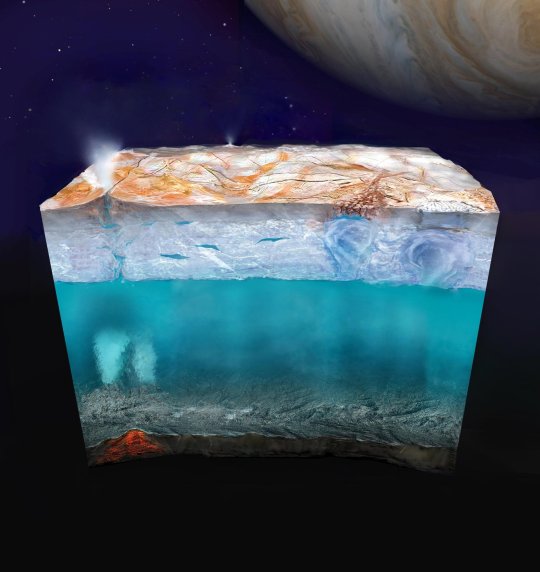

Can Life Exist on an Icy Moon? NASA’s Europa Clipper Aims to Find Out
With a spacecraft launching soon, the mission will try to answer the question of whether there are ingredients suitable for life in the ocean below Europa’s icy crust.
Deep down, in an ocean beneath its ice shell, Jupiter’s moon Europa might be temperate and nutrient-rich, an ideal environment for some form of life — what scientists would call “habitable.” NASA’s Europa Clipper mission aims to find out.
NASA now is targeting launch no earlier than Monday, Oct. 14, on a SpaceX Falcon Heavy rocket from Launch Complex 39A at NASA’s Kennedy Space Center in Florida.
Europa Clipper’s elongated, looping orbit around Jupiter will minimize the spacecraft’s exposure to intense radiation while allowing it to dive in for close passes by Europa. Using a formidable array of instruments for each of the mission’s 49 flybys, scientists will be able to “see” how thick the moon’s icy shell is and gain a deeper understanding of the vast ocean beneath. They’ll inventory material on the surface that might have come up from below, search for the fingerprints of organic compounds that form life’s building blocks, and sample any gases ejected from the moon for evidence of habitability.
Mission scientists will analyze the results, probing beneath the moon’s frozen shell for signs of a water world capable of supporting life.
“It’s important to us to paint a picture of what that alien ocean is like — the kind of chemistry or even biochemistry that could be happening there,” said Morgan Cable, an astrobiologist and member of the Europa Clipper science team at NASA’s Jet Propulsion Laboratory in Southern California, which manages the mission.
Ice Investigation
Central to that work is hunting for the types of salts, ices, and organic material that make up the key ingredients of a habitable world. That’s where an imager called MISE (Mapping Imaging Spectrometer for Europa) comes in. Operating in the infrared, the spacecraft’s MISE divides reflected light into various wavelengths to identify the corresponding atoms and molecules.
The mission will also try to locate potential hot spots near Europa’s surface, where plumes could bring deep ocean material closer to the surface, using an instrument called E-THEMIS (Europa Thermal Emission Imaging System), which also operates in the infrared.
Capturing sharply detailed pictures of Europa’s surface with both a narrow and a wide-image camera is the task of the EIS (Europa Imaging System). “The EIS imagers will give us incredibly high-resolution images to understand how Europa’s surface evolved and is continuing to change,” Cable said.
Gases and Grains
NASA’s Cassini mission spotted a giant plume of water vapor erupting from multiple jets near the south pole of Saturn’s ice-covered moon Enceladus. Europa may also emit misty plumes of water, pulled from its ocean or reservoirs in its shell. Europa Clipper’s instrument called Europa-UVS (Europa Ultraviolet Spectrograph) will search for plumes and can study any material that might be venting into space.
Whether or not Europa has plumes, the spacecraft carries two instruments to analyze the small amount of gas and dust particles ejected from the moon’s surface by impacts with micrometeorites and high-energy particles: MASPEX (MAss SPectrometer for Planetary EXploration/Europa) and SUDA (SUrface Dust Analyzer) will capture the tiny pieces of material ejected from the surface, turning them into charged particles to reveal their composition.
“The spacecraft will study gas and grains coming off Europa by sticking out its tongue and tasting those grains, breathing in those gases,” said Cable.
Inside and Out
The mission will look at Europa’s external and internal structure in various ways, too, because both have far-reaching implications for the moon’s habitability.
To gain insights into the ice shell’s thickness and the ocean’s existence, along with its depth and salinity, the mission will measure the moon’s induced magnetic field with the ECM (Europa Clipper Magnetometer) and combine that data with measurements of electrical currents from charged particles flowing around Europa — data provided by PIMS (Plasma Instrument for Magnetic Sounding).
In addition, scientists will look for details on everything from the presence of the ocean to the structure and topography of the ice using REASON (Radar for Europa Assessment and Sounding to Near-surface), which will peer up to 18 miles (29 kilometers) into the shell — itself a potentially habitable environment. Measuring the changes that Europa’s gravity causes in radio signals should help nail down ice thickness and ocean depth.
“Non-icy materials on the surface could get moved into deep interior pockets of briny water within the icy shell,” said Steve Vance, an astrobiologist and geophysicist who also is a member of the Europa Clipper science team at JPL. “Some might be large enough to be considered lakes, or at least ponds.”
Using the data gathered to inform extensive computer modeling of Europa’s interior structure also could reveal the ocean’s composition and allow estimates of its temperature profile, Vance said.
Whatever conditions are discovered, the findings will open a new chapter in the search for life beyond Earth. “It’s almost certain Europa Clipper will raise as many questions or more than it answers — a whole different class than the ones we’ve been thinking of for the last 25 years,” Vance said.
TOP IMAGE: This artist’s concept (not to scale) depicts what Europa’s internal structure could look like: an outer shell of ice, perhaps with plumes of material venting from beneath the surface; a deep, global layer of liquid water; and a rocky interior, potentially with hydrothermal vents on the seafloor. Credit: NASA/JPL-Caltech
LOWER IMAGE: The puzzling surface of Jupiter’s icy moon Europa looms large in this reprocessed color view made from images taken by NASA’s Galileo spacecraft in the late 1990s. The images were assembled into a realistic color view of the surface that approximates how Europa would appear to the human eye. Credit: NASA/JPL-Caltech/SETI Institute
41 notes
·
View notes
Text
[VIDEO FEED BEGINS]
Video opens to Pyroclast in the hold of her ship. The feed shakes as she sets the camera down on an object in the corner, waving a paw in front of it and snapping a few times for the camera to focus.
The feed is angled from a corner into the hold, with Pyroclast's Tokugawa 'Flashpoint' center frame. A Nelson's Perpetual Momentum Drive, or something that once was a Drive, is suspended beside the frame on chains. It has clearly been tampered with, and a great number of tubes wires and clamps run from the device to the Tokugawa's back.
Pyroclast beams, gesturing triumphantly to the slapdash assembly with both arms outstretched.
"Here it is! Draft one of the Perpetual Heat Battery! Up there I've got a PMD off a Nelson, jury-rigged with help from the Albatross- I'll have to tag them when I put this video up. Anyways! The actual backpack mount's next, I just wanna make sure the system's worked out okay."
She rushes off-screen for a moment, and a loud metal scraping sound is audible as she drags a waist-high crate between her and the Tokugawa.
"There we go! Safety second. Now then!"
She produces something that looks like a detonator from her pocket, crouching down behind the crate as Volta fades in over her shoulder to look at Flashpoint alongside her. The frame powers up, plates over the chest cavity splitting apart and retracting to reveal a cannon of some kind. It begins to glow, layers within the barrel starting to light up and spin, faster and faster.
"Okay, reactor's hot! Thermal demolition system up, Flashpoint's alive. Now let's start the PHB..."
She turns a dial on the detonator, at which point the Perpetual Momentum Drive hums to life. Its glow is different than a normal Drive's, and a faint heat mirage is visible in the air around it.
"Good, good, okay."
She turns to the camera, giving it a thumbs-up.
"Perpetual Heat Battery, version one! Hot and ready! Firing in THREE! TWO! ONE! FIRE IN THE HOLE!"
Her paw clenches around the detonator with a click. The Drive's humming reaches a crescendo, and then suddenly stops as the cannon in the Tokugawa's chest cavity emits a blinding white cone of heat and flame, crossing almost the entire hold. Then it's over.
Pyroclast shoots to her feet, arms raised triumphantly in a flash, spinning around to face the camera as she pumps her fists in the air.
"It works! It works! Fuck yeah, it works! Okay, next step is to make the-"
Suddenly, there's a metallic ping from the Drive, and a fist-sized chunk of metal goes flying past Pyroclast's face. Then, without warning, the camera is knocked to the ground as a thundrous explosion shakes the entire hold. Alarms start to blare, and the rush of depressurizing air giving way to hard vacuum takes over the remaining audio.
"Fire suppression systems engaged. Venting hold."
All audio is lost as the last of the air leaves. The feed cuts as Pyroclast picks up the camera and turns it off, a frazzled expression on her face.
[VIDEO FEED ENDS]
>> Welp, here's how it went.
>> The Winterhalter's all fixed up now, but. Well. That's what happened.
>> @albatross-lancer
[Pyroclast]
24 notes
·
View notes
Text
A voice cut through the grey.
Starting resuscitation.
It sounded almost distantly familiar, but she panicked when the IFF module didn't give an immediate response. A mental command, flicking the mass accelerator out of her left arm and… no confirmation. Her heart raced.
She tried bringing up her scope. Night vision. Thermal. No response.
Patient is experiencing spasms, requesting restraints!
Preparing for combat she braced for the euphoric cocktail of drugs that were about to be delivered into her system when the adrenalin spike was detected, starting to shake as the hit never came.
Running down the list of cockpit commands in a fervour, begging for feedback. HUD. Lights. Even the camera washer. Her mind hovered over the last two mental commands, one that would start an emergency eject that should work on the last remaining dregs of backup power, the other would deliver a fatal shock of electricity to the base of her neck. She weighed them evenly; if she was taken down by an EMP and being cut out, ejection would be certain death anyway.
Patient at risk of harm! I need help here!
With a determined mental nod she triggered the eject, trying to tense herself up and opened her eyes.
Instead of the inky-black comfort of the cockpit she was immediately overwhelmed with light. Nauseated she tried to throw up only to have a thin string of drool dribble down her chin. As things came into focus she was hit by a second wave of nausea. Sluggish motor inputs felt like twice the response time she was used to. Multiple ocular inputs overwhelmed with more visual feedback than she had with the mech's single TGP and laser rangefinder.
Finally she saw arms being held down. Not her arms. These were pale, thin and fragile things, twitching and shaking as someone held them down by the wrist. Knowing when she was beaten she sent the final mental command. Nothing. She was still here as she fell limp, her eyes catching a bare chest rising and falling in exertion out of the bottom of their field of view.
Seizure has subsided, testing reflexes.
Feeling started to return as blood pumped through her body. Not hydraulic oil or coolant. Blood. Right. The arms and chest were hers and the sound of her panicked breathing suddenly cut through the tinnitus, her body retching again.
Something loomed over her, blocking out the light before a pinprick blinded her again, waving back and fourth before winking out, consumed into the overhead blur again.
"Pupils slow to respond, suspected brain damage."
The voice, lacking any static from transmission, was right above her. She was just processing what had finally been understood when she felt a prick in her left wrist.
"Administering sedative for MRI."
Her nervous system jerked only to find muscles that wouldn't contract, paralysed as her mind once again faded into static.
#hazyposting#robot girl#girl#mechposting#mech pilot#writing#literally came to me in a dream#first time writing something like this since highschool
32 notes
·
View notes
Note
Hey there,
I'm interested in getting involved into a hobby level of natural photography. I was wondering what a good intermediate camera, and what top 3 lens (if any) you'd recommend. I love using my cellphone but some shots, like birds riding thermals or looking at a specific spot for a long time to get a good shot just isn't as easy with a phone. I intend to shop around and see if I can play with different things, but getting an entry level start point would be great.
Thanks!!
I'm going to assume you mean nature photography due to you mentioning birds. That does cover a lot of different things so it's hard to give you a great recommendation without more details. Your budget range and some more examples of what you'd like to photograph can help me help you a little better.
That said, I can give you an example of a general nature setup that I might suggest. I can't say if this exact system is a good fit for you without more information, but it can get you started in your research.
The big problem with nature is distance. A lot of the critters you may want to photograph are skittish and it is hard to get close enough to them and the big telephoto lenses can get quite expensive. There are superzooms that will technically work, but a lot of times their optical quality is not good enough to get artistic-quality shots. They would be more for documenting that you saw a thing rather than capturing a pretty shot of the thing. So if you see a zoom lens that goes from 100-600mm or 80-400mm... just anything with an extensive range... typically those are going to be low quality optics.
A trick to get a bit more range is to get a slightly smaller sensor. If you get an APS-C camera, it will essentially give you 1.5x additional zoom with every lens. But you sacrifice some dynamic range and low light ability. So dark scenes or scenes that are both very bright and very dark could be a challenge.
A very popular wildlife camera body is the Canon 7D mark II. It has a pretty advanced focusing system for a DSLR and can be found for a decent price on the used market.
You could get a 24-70mm f/4 lens for your general purpose photography. This can get wide angle shots for vistas and forests and also zoom in if you need to.
Perhaps a 100mm macro lens for taking pictures of bugs and flowers and mushrooms. But it is also slightly telephoto so you can capture some birds, larger mammals, and even take portraits of people too.
And then the Canon 400mm f/5.6 prime is a classic bird lens that is fairly telephoto, has good optics, and won't explode your budget.
And just because it is so dang inexpensive for what you get, the 50mm f/1.8 "Nifty Fifty" is always a good idea to get just so you have something that can work in very low light.
That would cover a pretty large swath of subject matter if you were to head into the wilderness to capture what you saw.
26 notes
·
View notes
Text
Quirks and features of the James Webb Space Telescope

The James Webb Space Telescope (JWST) is a ten billion dollar space telescope that weighs 14,000 pounds, is the size of a bus, and took decades to construct. It's been in the news recently, you might have heard about it.
The development, launch and deployment of the JWST were fraught with unexpected setbacks, terror and frights, 344 "single-point failures", any one of which that, if they failed during deployment, could doom the entire spacecraft to uselessness, since it orbits far out beyond where any current manned spacecraft could even attempt a repair job.
The fact that it came online as smoothly as it did was something of a surprise to the people in charge. Given the miracle of it making it to space at all, the press coverage of JWST has focused on the positives. But a stroll through the JWST user documentation by a curious reader reveals much that is interesting, or interestingly broken. Such as..
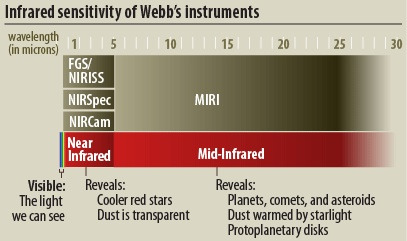
Fun and games with infrared
Specifically, the JWST is an infrared telescope, designed to collect light that's redder than red. The two dedicated imaging instruments are the Near Infrared Camera (NIRCam) collecting light from 0.6 micrometers to 5.0 micrometers and the Mid-Infrared Instrument (MIRI) collecting light from 5.6 micrometers to 25.5 micrometers. (Though with significant light collected past 25.5 um by filter F2550W)
The wonderful thing about infrared astronomy is that everything emits blackbody radiation, and the hotter it is the more infrared it emits. The unfortunate thing about infrared astronomy is that everything emits blackbody radiation, including your telescope, and self-emission from your telescope can swamp the faint signal from astronomical sources. (Like building a camera out of glowsticks.)
The equilibrium temperature for an object in Earth orbit is about 300 Kelvin. (26C) Everything on the other side of the sunshield passively cools down to 40K, and MIRI is actively cooled by the cryocooler down to a chilly 6K (-267C, -449F) This extends MIRI's seeing range deeper into infrared.
But the mirror is still warm! At the far end, MIRI is significantly compromised by thermal self-emission: (Note log scale!)
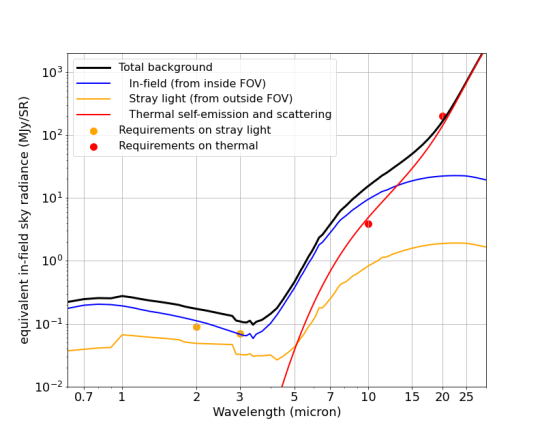
This is more graphically illustrated by one of the MIRI commissioning images:

Check out that background glare!
(This is somewhat unfair: the calibration target here is a star, which emits comparatively little light in far-infrared. MIRI is really meant for nebulae and extra-galactic high-redshift objects)
("Why not actively cool the mirror?" Mechanical cryocoolers operate on the very limit of what heat engines are capable of. The MIRI cryocooler draws a fat 180 watts to move 78 milliwatts of heat. Previous infrared telescopes used a fixed amount of expendable coolant (liquid helium or solid hydrogen) to cool the entire instrument package... at the cost of a much smaller primary mirror and a telescope that flat out just stopped working when it ran out of coolant.)
There's something else you might notice about the above series of photographs...
Thanks a lot, Lord Rayleigh
John William Strutt, 3rd Baron Rayleigh was a typical early physicist in that he has a great big pile of "discoveries" by virtue of being the first person to 1) notice something and 2) actually write it down. One of them is the fundamental theorem for the angular resolution of an optical system, the Rayleigh criterion. It is dead simple:

Resolution is roughly equal to 1.22 times the wavelength of the light you're looking at, divided by the diameter of the aperture. Bigger the opening at the front of light bucket, the higher the resolution. Smaller the wavelength of light, the higher the resolution.
(Fun fact: the former Arecibo radio observatory, once the largest single telescope in the world with a 305 meter wide dish, had about the same angular resolution in radio waves as the human eye does in visible light.)
You can imagine the effect this has on an infrared telescope. And sure enough, in the user documentation for the two imaging sensors, it states a pixel scale of 0.031 arcseconds for 0.6 to 2.3 micrometers light wavelength, 0.063 arcsec/px for 2.4-5.0 µm, and a squishy 0.11 arcsec/px for 5.6-25.5 µm.
But this is just how many pixels are on the detector. The resolution gets much worse at long wavelengths, as you can see in the commissioning image, where the extra pixels oversample a progressively vaguer blob. The Rayleigh criterion holds that the 6.5 meter wide JWST primary mirror should manage 0.206 arcsec at 5.32 µm, falling to 0.42 arcsec at 10.85 µm, 0.747 arcsec at 19.29 µm, and an unfortunate 1.014 arcsec at 26.2 µm. One wonders why the designers went to heroic lengths to cool MIRI down to 7 kelvin, instead of using that cryocooler mass and power budget for more detector surface area.
Knowing this, you can spot how the JWST's press team works around the limitations of the telescope. Like how a "look at how good our infrared telescope" commissioning photo happens to use the 7.7 µm mode:

Or how if you browse the photos on the webbtelescope.org site, you will see lots of NIRcam output in the "oooh, ah, new desktop background" category, but not so much MIRI.
(Another amusing detail of MIRI is that bright objects leave afterimages ("latents") on the sensor, so once a week they warm the sensor up to a tropical 20 kelvin before cooling it down again, a "MIRI anneal". You can see when anneals are performed, as well as what the telescope is looking at right now, by viewing the public schedule.)
But this is Webb operating right up to its full specifications. How about something that's actually broken?
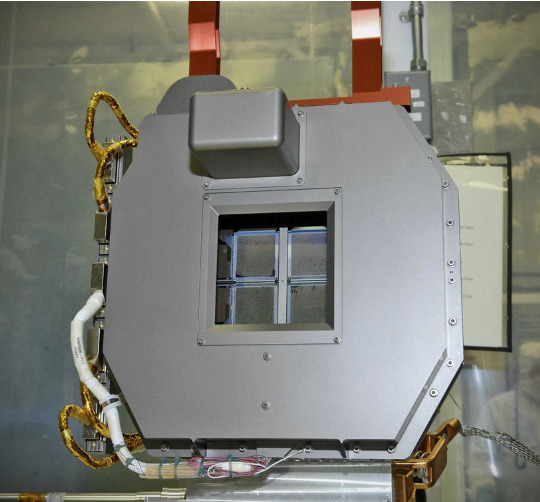
NIRSpec my beloved
The Near-Infrared Spectrograph (NIRSpec) instrument takes incoming light and runs it through a diffraction grating to produce a spectrum. When scientists say that the Sun is 0.77% oxygen, 0.29% carbon, etc, it's not because someone flew a spacecraft over to it and collected a bucket of solar plasma, it's because you can look at the absorption lines in the spectra to figure out its composition.
Spectrometry is also used to measure redshift, a close proxy to distance. When a press release says that a galaxy is "ten million lightyears away", it's not because NASA has a really long tape measure they haven't told anyone about, it's because a spectrometer measured how much cosmological redshift has moved a spectrum line. Naturally, it's not quite as easy as pointing a sensor at a object and getting back a single, unambiguous result. Distant objects are also dim objects, so the spectra will be noisy and chewed up by dust and other contamination its endured in the millions of years its traveled to arrive at our telescopes. Bleeding edge astronomy is thus the practice of designing statistical models to fit to noisy, fragmented data, and then arguing with other astronomers about r^2.
In any event, it's a handy thing to have on a telescope. Naturally, JWST has more than one. In fact every instrument has a spectroscopy mode. Besides the dedicated NIRISS and NIRSpec instruments, both NIRcam and MIRI include diffraction gratings in their filter wheels that smear out incoming light, like looking through a prism:
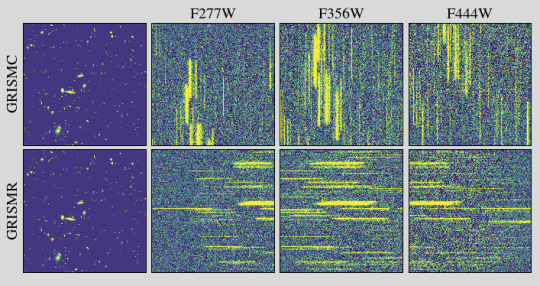
Pointing the JWST at an object is relatively expensive, since it requires rotating ("slewing") the entire darn spacecraft, and an amusingly complex alignment procedure with the fine guidance sensor and fine steering mirror. Considering how long it would take to shoot a hundred spectra with a conventional fixed slit rigidly mounted to the telescope frame, you can see the appeal of gathering a hundred spectra in a single exposure with "slitless" spectroscopy.
(Longtime space telescope nerds might hear the word "slewing" and involuntarily twitch, recalling that the reaction wheels and gyroscopes were a problem point on the Hubble, requiring several servicing missions, and also significantly affecting operations on the Kepler space telescope. Fortunately, JWST switched to a gyroscope type that has no moving parts, and used some mass budget to install six reaction wheels, up from Hubble's four, giving it three spares.)
You can also see the big downside in the image above, which is there's a hard tradeoff between how long a spectrum can be (and thus its resolution!) before it'll overlap its neighbors and be useless. Most of the slitless modes therefore have two gratings at two different angles, (GRISMR and GRISMC above) but wouldn't it great if you could just block out all that other light?

Thus, the Micro Shutter Array, as seen above. The best of both worlds! Capture many spectra at the same time, while blocking off light you don't want from contaminating the field, using a configurable array of nearly a quarter million microscopic, individually actuated moving shutters.
Lots and lots and lots of tiny little moving parts, installed in the guts of a spacecraft that's orbiting out past the Moon, impossible to access or replace.
Yeah, a bunch of them broke:

When it was handed over to NASA for installation into Webb in 2007, the MSA already had 150 shutters that no longer responded to opening commands in just one of the four submodules.
By the time JWST emerged from commissioning and was declared fully operational in 2022, 15,893 shutters, 7% of the total, had "failed closed." Hilariously, 904 of those failed during post-launch testing, and the authors of that paper note that, on average, if you tell 100 shutters to close, 4 of them will jam shut and no longer work.
This is unfortunate, but fairly easy to work around. What's worse are the shutters that are stuck open:
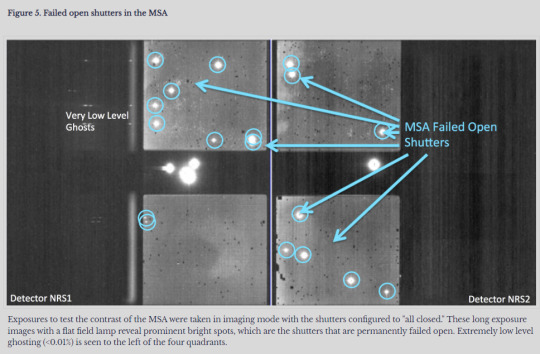
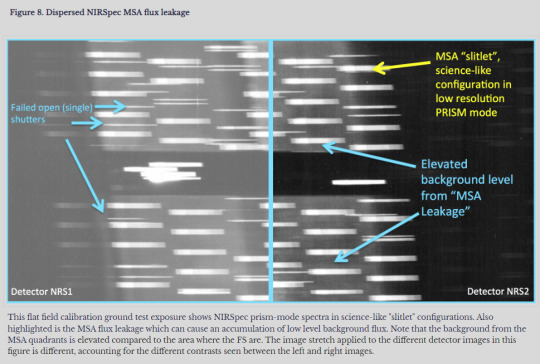
These permanently open shutters then compromise big chunks of the sensor. Commissioning testing jammed two more of them open, taking the total up to 22. You can imagine that if a few dozen more of these fail-open during routine operation then the entire microshutter array observation mode won't be much more useful than regular slitless spectrography.
And this, right here, sums up the essentially "interim" nature of JWST. After all, it was only supposed to cost $500 million and take a mere nine years from design to launch. All becomes clear in that light. Why give it a shutter array that falls apart in use? Why have the mirror exposed to space, where it gets hit with micrometeoroids? Why only design it to carry ten years worth of fuel? Because it was supposed to be half the price of Hubble!
The 90s was the era of "faster, better, cheaper". JWST was going to be an incremental improvement on a long series of previous infrared telescopes, and a stepping stone to the next one. It wasn't supposed to be an eternal monument to Science, and a financial black hole consuming NASA's entire budget.
So what went wrong?
We shouldn't have built one JWST.
Those 344 single points of failure. Any single one of them can end the mission. There's just one telescope, no backups, no trying again. Bureaucrats are harshly punished for failure, lightly rewarded for success. It's always easier to wait, do more tests, delay the schedule a bit more at a hint of trouble. Engineers can get you to 90% reliable no problem, but getting to 99% reliable takes another decade and nine billion more dollars.
Our techne is just bad at producing flawless machines first try. For the price of one reliable JWST we could have put twenty into orbit... but the first five would have been embarrassing failures. Spars sticking in place, sunshields jamming, thrusters misfiring. To save the shame of $0.5 billion wasted, NASA happily spent $9.5 billion. Why not? Because money spent is invisible, but failure is painfully apparent.
A critical third party can draw unflattering parallels. The crowning achievement of NASA, the Moon Landing... required eleven Apollo launches and twenty Surveyor launches before a single man set foot on lunar regolith! Quite a few of those spacecraft pancaked into the Moon and exploded on the launchpad before we figured out this "space" thing. Three men died! But NASA was on a hard deadline, with a fixed budget, and the only way to get a home run is to take a lot of swings at the ball.
Another comparison is the Space Launch System, NASA's attempt to make the Saturn V again. So far $27 billion has been lit on fire to put exactly one test load into orbit, with the primary contractor now desperate to get out of its contact. Slow, careful, incremental development has completely failed to produce a working launch system.
Meanwhile, SpaceX produced a series of public, embarrassing failures... resulting in the world's only reusable launch system, and as a result has put far more mass into orbit than any country in the world.
The only way to develop a flight system is flight tests.
Space telescope deploy mechanisms meant to work in zero gravity can't be tested on the ground.
They can only be tested in space.
NASA administrators who didn't work during Apollo are too stupid to understand this. Fire them all!
These geriatrics have happily sacrificed science in order to play it safe and secure their own easy retirement. Do we want 15 risky JWST telescopes by 2010, or do we want one reliable one by 2022? The answer is obvious!

For the money we wasted making Webb more reliable, we could have launched a space telescope far outside the disk of dust in the inner solar system, allowing it to see deeper into space than Webb ever could. ESA put an astrometry space telescope just outside Earth orbit, measuring angles between stellar objects, which is the only way to directly measure the distance to the stars. Great first step. The obvious next step is to send more of these telescopes out past Neptune's orbit, to capture better observations with a vastly larger baseline, something that can never be done by an Earthly observatory. Are there any plans to do this? No!
Space exploration is paralyzed by boomers, mired in the mental tarpit of the 1970s, where each gram to orbit is terribly expensive and must be counted on punched cards and summed with slide rules. Meanwhile, SpaceX Starship is on its way to orbit, and each one can carry sixteen JWSTs with room to spare!
The old paradigm is done. Telescopes don't need folding mirrors and exotic materials, they need to be mass produced. There is no excuse not to have a hundred more JWST-class telescopes lined up next to the Texas launch pad waiting for Starship to come online. But as far as I know not a single space mission even mentions it-- that's how afraid they are of risk!
The JWST, with its myriad of fragile components and its staggering price tag, stands as a monument not to our ingenuity but to our inability to let go of outdated ideals.
We must abandon the notion that space is a realm reserved for the flawless and the infallible. Instead, we should embrace the chaos, the unpredictability, the sheer messiness of exploration. Let us launch a thousand telescopes, each a patchwork of parts, each destined to fail in its own spectacular way. For it is only in this embrace of the ephemeral that we can find out what actually works!
Let the JWST be the last of its kind, a relic of a bygone era. The future is unwritten, and it is ours to fill with a symphony of failures, each note a step closer to the stars.
278 notes
·
View notes
Text
Student Experiments Soar!
youtube
Have you ever wondered what it takes to get a technology ready for space? The NASA TechRise Student Challenge gives middle and high school students a chance to do just that – team up with their classmates to design an original science or technology project and bring that idea to life as a payload on a suborbital vehicle.
Since March 2021, with the help of teachers and technical advisors, students across the country have dreamed up experiments with the potential to impact space exploration and collect data about our planet.
So far, more than 180 TechRise experiments have flown on suborbital vehicles that expose them to the conditions of space. Flight testing is a big step along the path of space technology development and scientific discovery.
The 2023-2024 TechRise Challenge flight tests took place this summer, with 60 student teams selected to fly their experiments on one of two commercial suborbital flight platforms: a high-altitude balloon operated by World View, or the Xodiac rocket-powered lander operated by Astrobotic. Xodiac flew over the company’s Lunar Surface Proving Ground — a test field designed to simulate the Moon’s surface — in Mojave, California, while World View’s high-altitude balloon launched out of Page, Arizona.


Here are four innovative TechRise experiments built by students and tested aboard NASA-supported flights this summer:
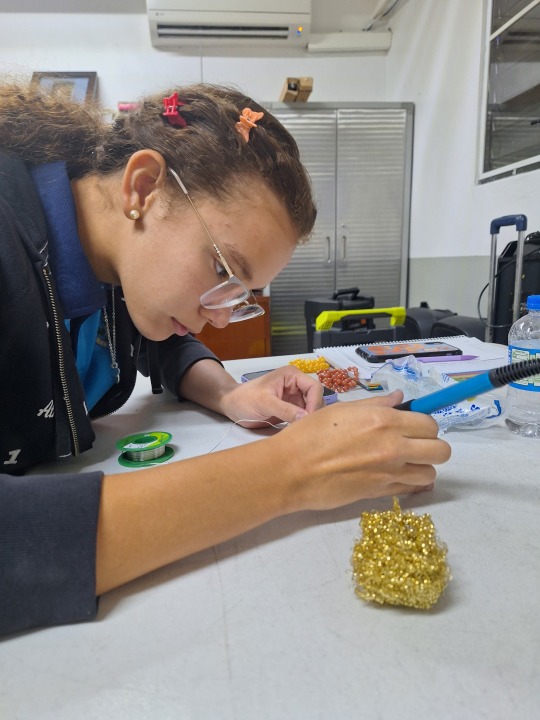
1. Oobleck Reaches the Skies
Oobleck, which gets its name from Dr. Seuss, is a mixture of cornstarch and water that behaves as both a liquid and a solid. Inspired by in-class science experiments, high school students at Colegio Otoqui in Bayomón, Puerto Rico, tested how Oobleck’s properties at 80,000 feet aboard a high-altitude balloon are different from those on Earth’s surface. Using sensors and the organic elements to create Oobleck, students aimed to collect data on the fluid under different conditions to determine if it could be used as a system for impact absorption.

2. Terrestrial Magnetic Field
Middle school students at Phillips Academy International Baccalaureate School in Birmingham, Alabama, tested the Earth’s magnetic field strength during the ascent, float, and descent of the high-altitude balloon. The team hypothesized the magnetic field strength decreases as the distance from Earth’s surface increases.
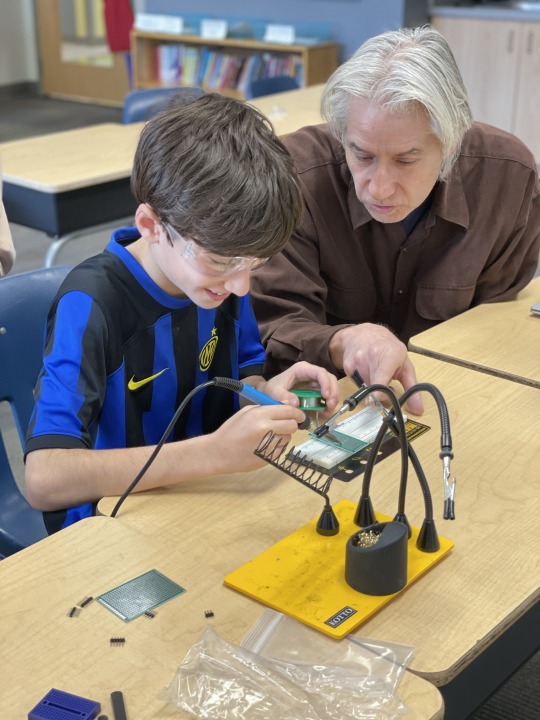
3. Rocket Lander Flame Experiment
To understand the impact of dust, rocks, and other materials kicked up by a rocket plume when landing on the Moon, middle school students at Cliff Valley School in Atlanta, Georgia, tested the vibrations of the Xodiac rocket-powered lander using CO2 and vibration sensors. The team also used infrared (thermal) and visual light cameras to attempt to detect the hazards produced by the rocket plume on the simulated lunar surface, which is important to ensure a safe landing.
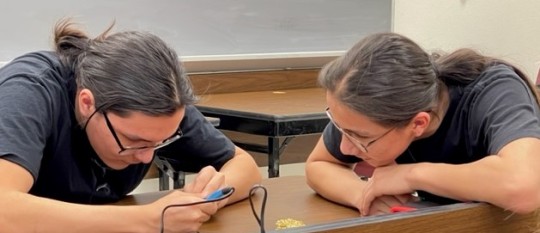
4. Rocket Navigation
Middle and high school students at Tiospaye Topa School in LaPlant, South Dakota, developed an experiment to track motion data with the help of a GPS tracker and magnetic radar. Using data from the rocket-powered lander flight, the team will create a map of the flight path as well as the magnetic field of the terrain. The students plan to use their map to explore developing their own rocket navigation system.
youtube
The 2024-2025 TechRise Challenge is now accepting proposals for technology and science to be tested on a high-altitude balloon! Not only does TechRise offer hands-on experience in a live testing scenario, but it also provides an opportunity to learn about teamwork, project management, and other real-world skills.
“The TechRise Challenge was a truly remarkable journey for our team,” said Roshni Ismail, the team lead and educator at Cliff Valley School. “Watching them transform through the discovery of new skills, problem-solving together while being driven by the chance of flying their creation on a [rocket-powered lander] with NASA has been exhilarating. They challenged themselves to learn through trial and error and worked long hours to overcome every obstacle. We are very grateful for this opportunity.”
Are you ready to bring your experiment design to the launchpad? If you are a sixth to 12th grade student, you can make a team under the guidance of an educator and submit your experiment ideas by November 1. Get ready to create!
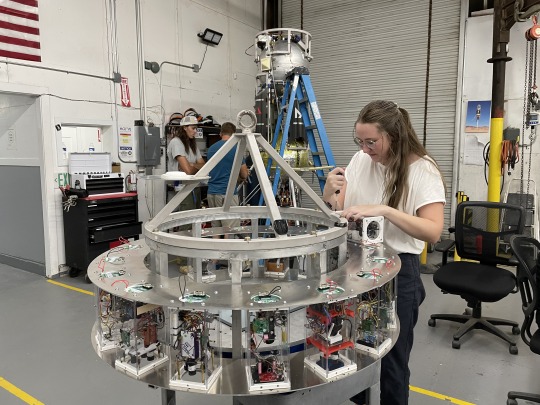
Make sure to follow us on Tumblr for your regular dose of space!
603 notes
·
View notes
Text
Cancelled Missions: Gemini Saturn V

-Concept Art, however this has a typo, as this is clearly the Saturn V.
"American manned lunar orbiter. In l LP late 1964 McDonnell, in addition to a Saturn IB-boosted circumlunar Gemini, McDonnell proposed a lunar-orbit version of Gemini to comprehensively scout the Apollo landing zones prior to the first Apollo missions.
Status: Design 1964. Gross mass: 11,182 kg (24,652 lb).
The lunar orbit version required an Agena stage to provide the delta-V for lunar orbit insertion and trans earth injection. The 1.52 m-diameter Agena was enclosed in an inverted conical fairing to both transmit thrust loads to the Gemini and provide thermal protection during the coast to the moon.
Alternatively, a propulsion module based on a repackaged Apollo Service Module propulsion system, as had been proposed two years earlier for a lunar-landing version of Gemini, could be used. This raised the translunar injection mass of the spacecraft to 11,182 kg, well above the capability of a Saturn IB or Titan III-C, but only a quarter that of a Saturn V. The launch vehicle was unspecified, but could only have been a Saturn V used on an early test mission. The mission profile would have involved a 68 hour flight from low earth orbit to lunar orbit, a 24 hour lunar mapping mission in a 10 nm x 80 nm lunar orbit, and a 68 hour return flight. The scientific equipment would consist of a modest camera array installed in the nose of the spacecraft. This consisted of a long focal-length telescope, to which were attached two narrow-field stereo mapping cameras, a wide field mapping camera, a panoramic camera, and two 16 mm film cameras. The film was not accessible by the astronauts, being stored in a film vault shielded against radiation in the nose of the spacecraft. The camera compartment would protrude from the stub nose of the Gemini after parachute deployment.
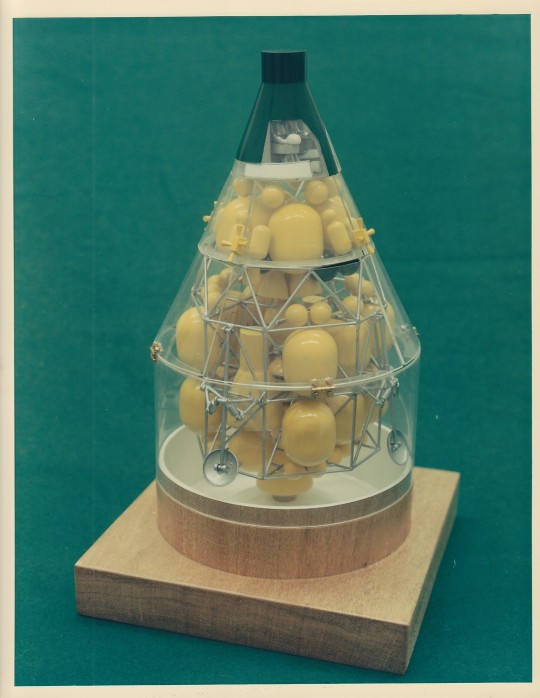
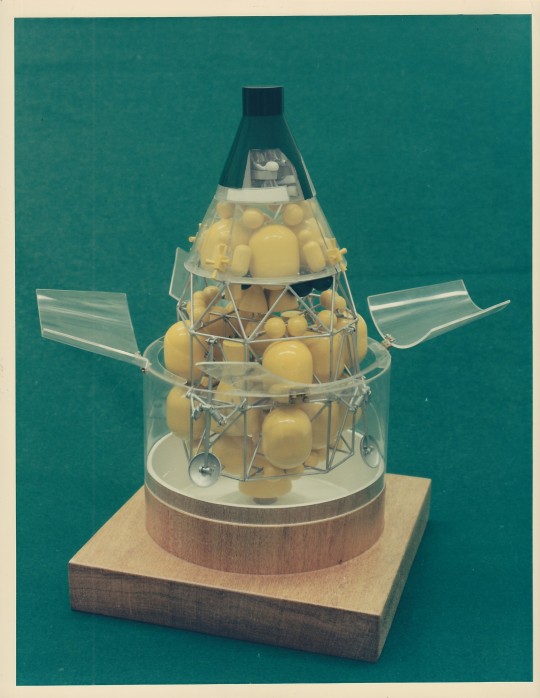
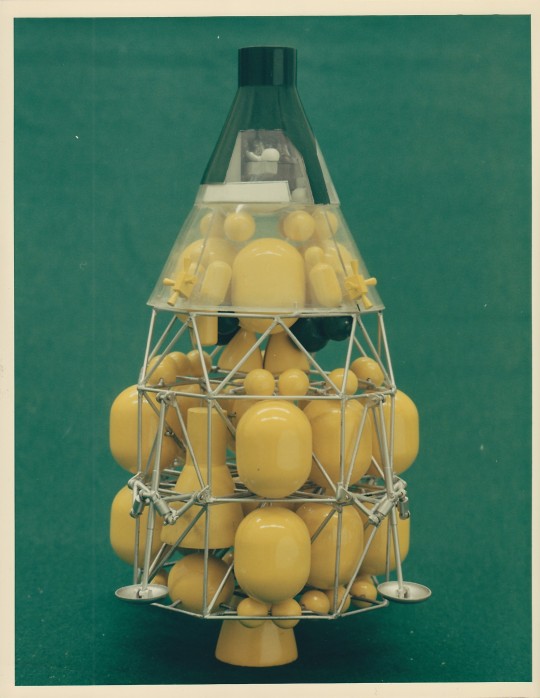
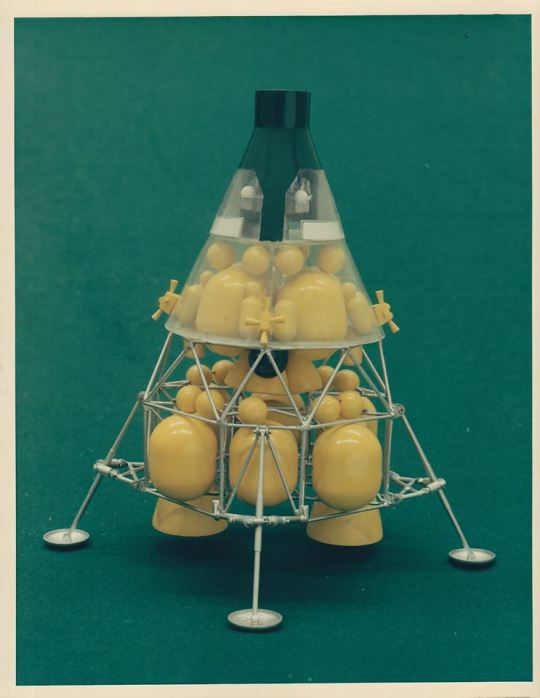
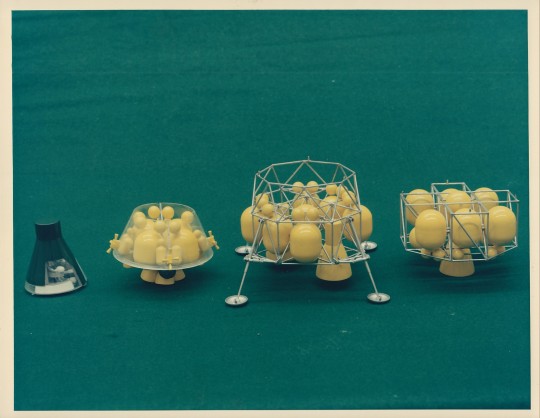
The manned portion was the same as the circumlunar version, a modified earth-orbit Gemini. The aft modules would be retained, but with the retrorockets removed. The retro module space would be used to install Apollo-type lunar distance communications, navigation, and test equipment. Deployable DSIF omni-directional and parabolic antennae would deploy from the aft modules to support lunar-distance communications. To handle re-entry from lunar distances, several modifications were necessary. The capsule's heat shield would be beefed up, and the Rene 41 corrugated shingles of Gemini's skin would be replaced with ablative shingles. The load of attitude control propellant for the capsule's reaction control system was substantially increased. Additional strap-down gyros and solar sensor packages would be added to provide navigation system redundancy. The ejection seats would be deleted and a Mercury-style launch escape tower added. The then-planned Rogallo wing recovery system would be used to glide to the Gemini to a runway landing on US territory after return from the moon. To handle the scientific payload, a camera compartment was added to the nose below the parachute/Rogallo wing housing. The Gemini spacecraft modified in this way had on on-orbit mass of 3955 kg as compared to the 3207 kg of the earth-orbit version.
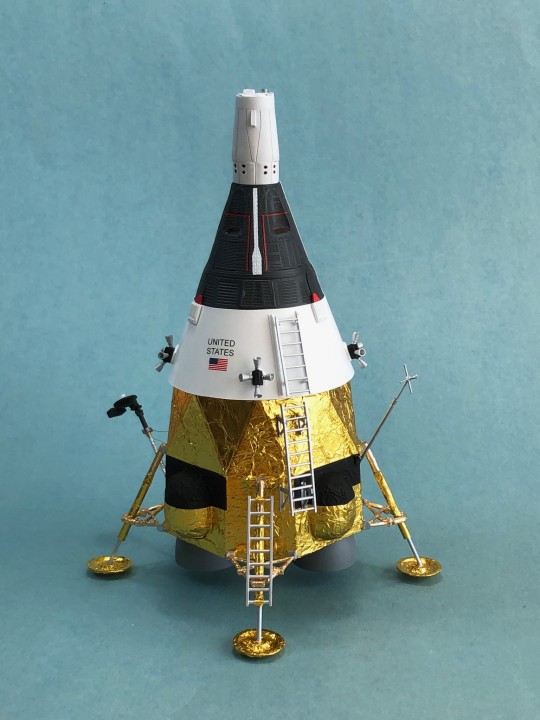
Crew Size: 2. Habitable Volume: 2.55 m3."
-information from Astronautix.com: link
source, source, source
#Gemini Saturn V#Gemini#Gemini Capsule#NASA#Gemini Program#Project Gemini#Saturn V#Rocket#concept art#artwork#cancelled#Lunar Gemini#1964#preliminary design#Cancelled Mission#my post
65 notes
·
View notes